- Content Marketing Services

Best NYC Day Trips by Metro-North Railroad
- By: Mary Spadoni
Have you ever looked at a picture of someone blissfully striding down a mountainous path as a glimmering river beckons in the distance and thought, “that must be nice, but I’m in New York City and don’t have a car – how the heck am I supposed to get to wherever that is?”
You’ve come to the right place! This guide will tell you everything you need to know about the best and easiest NYC day trips without a car. Yes, you read that correctly. There is an entire world beyond New York’s five boroughs, and much of the surrounding Hudson Valley attractions and countryside are extremely accessible thanks to the city’s Metro-North train lines.
What is Metro-North Railroad?
The Metro-North Railroad is the suburban commuter train service for the greater New York City region. It reaches west into New Jersey, north into New York’s Hudson Valley, and northeast along the southern border of Connecticut, making the Metro-North one of the easiest ways to take an NYC day trip without a car. There are five different lines that reach a total of 124 stations – the Port Jervis and Passaic Valley lines begin at Penn Station, and the Hudson, Harlem, and New Haven lines start at Grand Central Station.
Prices for a ride on a Metro-North train depend on three things – when and where you’re going, and where you buy your tickets. Rides are priced according to length of trip and peak vs. off-peak times, and it’s helpful to remember that Metro-North peak hours are between 6am and 10am for trains arriving in NYC and between 4pm and 8pm for trains departing NYC. Tickets are also more expensive if you buy them onboard, so to avoid overpaying, either purchase your ticket from a kiosk in the train station or through the eTix app .
Keep in mind that this pricing structure is different from the city’s subway system, despite both entities existing under the MTA. And no, your subway card won’t work on a Metro-North train.
Best NYC Day Trips on Metro-North
With so many destinations accessible via a Metro-North Railroad train, it can be hard to figure out the best place for NYC day trips or weekend getaway without a car. Read on for our suggestions!
Rockefeller State Park Preserve
Metro-North stop: Tarrytown
Trip length: 45 minutes from Grand Central Station on the Hudson Line
Only 30 miles north of the city, Rockefeller State Park Preserve is home to forested hills, sunlit valleys, and quiet countryside walks, and is one of the best quick NYC day trips by train. It’s also a major birdwatching destination – 202 species of birds have been spotted amongst the preserve’s wooded trails, designating the park an Important Bird Area by the National Audubon Society. From migrating buffleheads to 34 different species of warblers and even the occasional bald eagle, anyone from beginner birdwatchers to seasoned ornithologists will find something to point their binoculars towards. Looking to get into birding? Check out our beginner’s guide to birdwatching !
The Preserve also has a partnership with Stone Barns Center for Food and Agriculture , a collective of conservation planners, organic farmers, educators, and chefs who are creating a sustainable food ecosystem that connects the local community to delicious and innovative cuisine. The Center is open to the public for behind-the-scenes tours of their Innovation Labs, grounds, and growing spaces, and is one of the top Hudson Valley getaways. Or, hop on this tour from Go Love NY , which combines a private tour of Stone Barns with a tasting at nearby Captain Lawrence Brewery, the Hudson Valley’s largest craft brewery.
Harriman State Park

Metro-North stop: Tuxedo
Trip length: 1 hour from Penn Station, transfer at Secaucus Junction to the Port Jervis Line
Harriman State Park , located west of the Hudson River, is BIG. With 44,000 acres and over 200 miles of hiking trails, it’s the second-largest state park in New York. And at just one hour from the city, Metro North makes it a super easy day trip from NYC without a car. One of the Park’s best hikes is the Ramapo-Dunderberg Trail, a Moderate-rated 3.5 mile hike over several creek crossings and some fun rock scrambles. Thinking about a new pair of hiking boots? Get inspired with our guide to sustainable shoes !
Old Croton Aqueduct Trail
Metro-North stop: Philipse Manor (in the town of Sleepy Hollow)
Trip length: 1 hour from Grand Central Station on the Hudson Line
Created in 1842 as the city’s first water supply system, the Croton Aqueduct was renamed the Old Croton Aqueduct when a newer and much bigger conduit was built nearly 50 years later. The aqueduct was later purchased by the Parks Department and eventually turned into what we now know as the Old Croton Aqueduct Trail , which meanders 26 miles from Van Cortlandt Park in Yonkers to the Croton Dam in Cortlandt, NY. It’s entirely possible to walk or run the entire trail, but if you only have the time in your NYC day trip to tackle a smaller section, try the 7-mile stretch between Sleepy Hollow and Hastings-on-Hudson. You’ll pass through charming communities, get a great view of the newly constructed Gov. Mario M. Cuomo Bridge, and stroll through the grounds of Lyndhurst , a gorgeous Gothic Revival mansion.
You might also choose to bike your way along the aqueduct, but you’ll find a variety of surfaces throughout the trip, including gravel, dirt, and grass, which will make for an uneven ride. Additionally, the path often uses public roads, so be prepared to navigate around pedestrian sidewalks and vehicle traffic. A mountain or dirt bike is strongly recommended over a road bike if you’re planning to tackle the trail on two wheels. And as long as those wheels are 27” or less in diameter, you can bring your bike on any Metro-North train without a permit .
Sing Sing Kill Brewery
Metro-North stop: Ossining
Trip length: 1 hour, 5 minutes from Grand Central Station on the Hudson Line
The Sing Sing Kill Brewery was designed to be an all-inclusive gathering space in an underserved downtown Ossining, and a catalyst for its local economy. Their sustainably produced beer uses locally sourced energy, equipment, and ingredients, with most beer styles sourcing 100% of their malt and hops from within New York State. Take a tour of the brewery or pull up a seat in their taproom, which offers tastings of their full line as well as guest taps from NY Farm craft brewers and a selection of NY State Spirits from the surrounding Hudson Valley.
Manitoga – The Russel Wright Design Center
Metro-North stop: Garrison
Trip length: 1 hour, 20 minutes from Grand Central Station on the Hudson Line
American product and furniture designer Russel Wright believed that good design lived in creative harmony with nature and the surrounding environment. These principles thrive at Manitoga , his former home, and workspace. Here you can get a firsthand look at the artist’s studio, mid-century modern home, and the 75 acres of woodland gardens that inspired his work. The property’s trails are open to the public for easy solo hiking, or you could join a guided landscape hike to learn about the rich biodiversity in Hudson Valley, NY.
Hudson Highlands State Park Preserve
Metro-North stop: Cold Spring
Trip length: 1 hour, 25 minutes from Grand Central Station on the Hudson Line
On the east side of the Hudson River is the delightful town of Cold Spring. The Metro-North Railroad definitely makes this one of the best day trips from NYC without a car. Cold Spring is the gateway to Hudson Highlands State Park. With 8,000 acres of mostly undeveloped woodland preserve, it’s one of the best hiking and wildlife destinations in the Hudson Valley. There are three trails to put on your radar. For those looking for a less strenuous experience, the Little Stony Point Short Loop is an Easy-rated .09-mile walk through a lovely part of the forest. If you’d like a long trail, the Bull Hill Full Loop is rated Moderate and will take you 5.4 miles past an abandoned rock quarry, early 20th-century farm ruins, a waterfall, and more than one excellent view of the Hudson Valley. Up for a challenge? Consider Breakneck Ridge , an 11.4-mile, Hard-rated hike full of rock scrambles, elevation gains, and stunning scenery.
A note of caution: this area can get pretty buggy, especially in the spring and fall (we speak from unfortunate experience). Douse yourself in some eco-friendly insect repellent before heading out and keep those ticks away.
A Sustainable Weekend Escape in Beacon, NY
Metro-North Railroad Stop: Beacon
Trip length: 1 hour, 30 minutes from Grand Central Station on the Hudson Line
There are a ton of exciting things to do in Beacon, NY, but one of our personal favorites, and one of the best Hudson Valley attractions, is Dia: Beacon , a contemporary art museum housed in a former Nabisco printing factory. It features works by late-20th century heavy hitters like Dan Flavin, Richard Serra, and Andy Warhol. After you’re done marveling at a larger-than-life art installation, it’ll be time for lunch at Vegetalien , a locally sourced, 100% plant-based cafe and juice bar in downtown Beacon. Then, cap off your day with a tasting at Hudson Valley Brewery , where they use renewable energy to brew their entire line of craft beers, or Denning’s Point Distillery , who sources locally grown grains for their seven different spirits. Pro tip: grab a drink to go for your ride back to the city – it’s legal to consume alcohol on Metro-North trains. Just remember to drink responsibly!
But wait, there’s more!
Have some extra time in your schedule? There are so many great things to do in Beacon, NY, you might consider turning your Hudson Valley day trip into a long weekend in Beacon with a stay at the Roundhouse , a 200-year old property whose owners saved the buildings from demolition and restored as much of the original structures as possible.
On your second day in Beacon, NY, take a guided kayak and walking tour of Bannerman Castle , an abandoned 100-year old castle on an uninhabited island in the middle of the Hudson River and one of the top Hudson Valley attractions. Or, you might opt for a 2-hour sail on the Hudson River Sloop Clearwater , a 106-foot long tall ship that conducts on-board environmental education sessions and works to protect the ecology of the Hudson River. When you’re back on dry land, use your reusable shopping bag to pick up some fresh fruits and veggies at the Sunday Beacon Farmers’ Market , which helps support local farms and businesses.
Watersports on the Long Island Sound
Metro-North Railroad Stop: Westport
Trip length: 1 hour, 40 minutes from Grand Central Station on the New Haven Line
Thanks to its relatively calm waters, The Long Island Sound is a great place to get your feet wet (literally), and makes for one of the best day trips from NYC to Connecticut. Don’t know your bow from your stern? Sea Kayak Connecticut has you covered. In addition to renting individual kayaks, stand-up paddleboards, and peddle kayaks by the hour, they also offer half-day introductory kayaking classes and guided tours of nearby coastal islands like Cockenoe Island and Sprite Island. Alternatively, heed your need for speed on a Fliteboard eFoil, an emission-free, battery-powered surfboard that allows you to glide above the surface of the water at 20 miles an hour. Fliteschool Fairfield will teach you all you need to know and will have you flying in no time. And while we’re on the topic of water sports, let’s not forget about frozen water sports — you can go cross country skiing near New York City in a variety of beautiful destinations.
Need a new swimsuit for your day on the water? Check out our guide to the best sustainable swimwear brands !
Walkway Over the Hudson
Metro-North stop: Poughkeepsie
Trip length: 2 hours from Grand Central Station on the Hudson Line
Soaring 212 feet over the Hudson River, the pedestrian walkway on the steel cantilever Poughkeepsie Bridge provides some of the best views in Hudson Valley, NY. The wheelchair-accessible and bike-friendly Walkway Over the Hudson spans 1.28 miles from Poughkeepsie, NY on the east side of the river to Highland, NY on the west, and is perfect for a leisurely stroll, a quick run, or anything in between. Walking back over the bridge to Poughkeepsie makes the trip almost 2.5 miles long, so make sure to refuel at Laughing Gut Kombucha , the area’s only kombucha taproom, before catching your train back to the city.
We hope this guide to the best day trips from NYC without a car will help you leave those crowded city streets behind and immerse yourself in more than a few wide-open spaces. See you on the Metro-North!
Hey reader! Some of the links in this post are affiliate links. This means that if you make a purchase using any of these links, we’ll earn a small commission at no extra cost to you. Hidden Lemur is committed to promoting sustainable travel, and we only partner with brands that we believe contribute positively to that causebeau
Mary Spadoni
- / Uncategorized
Join the Hidden Lemur Mailing List
Related posts, ultimate guide to reef safe sunscreen, 10 interesting facts about vietnam , best travel rain ponchos [sustainable materials], ultimate guide to hiking mount olympus, greece, solo female travel: how to stay safe, how to experience epic animal migrations around the world, how to travel on a budget sustainably, guide to unesco world heritage sites, things to do in raleigh, durham, & chapel hill, nc, best things to do in thessaloniki, greece, cultural tours: what to look for, things to do in jungfrau region, switzerland, ultimate guide to slow travel, best dark sky locations for stargazing, 16 best hiking boot brands for outdoor enthusiasts, best things to do in tanzania, 8 of the best travel luggage brands (eco-friendly), things to do in são paulo, brazil, things to do in chicago, illinois (sustainable travel guide), the ultimate guide to ethical coffee, what is greenwashing, the ultimate guide to sustainable travel terms, 100+ travel statistics and facts to know for 2023, best things to do in paris [sustainable travel guide], 7 incredible sustainable yoga clothes brands [2023 edition], 70+ of the best travel quotes for 2023, best things to do in santa fe, new mexico, 14 new year resolutions for 2023 [eco-friendly edition], 12 ethical photography tips for travelers, the ultimate guide to vegan traveling, 10 sustainable things to do in edinburgh, scotland, complete busuu review: a worthy language learning app, top things to do in santiago, chile (sustainable travel guide), the winds of la guajira.
- Awards Season
- Big Stories
- Pop Culture
- Video Games
- Celebrities
Exploring Metro North Schedule and Fares for Tourists: A Visitor’s Guide
If you’re planning a trip to the bustling cities and picturesque towns of the New York metropolitan area, the Metro North train system is an excellent way to navigate the region. With its extensive network of routes and convenient schedules, Metro North offers tourists a reliable and efficient mode of transportation. In this guide, we will explore everything you need to know about Metro North schedule and fares to make your visit seamless and enjoyable.
Understanding Metro North Routes
Metro North operates three major lines: Hudson, Harlem, and New Haven. Each line covers different parts of the metropolitan area, making it easy for visitors to explore various attractions. The Hudson line runs along the scenic Hudson River, offering breathtaking views of the river valley and stopping at popular destinations like Peekskill, Cold Spring, and Beacon. The Harlem line extends north from Grand Central Terminal through charming suburban towns such as White Plains, Scarsdale, and Chappaqua. The New Haven line connects New York City with Connecticut cities like Stamford, Bridgeport, and New Haven.
To plan your itinerary efficiently using Metro North trains, familiarize yourself with these lines’ routes to determine which destinations you’d like to visit. Whether you’re interested in exploring vibrant cities or immersing yourself in nature’s beauty along the Hudson River Valley trails or Connecticut’s coastal towns, Metro North has got you covered.
Navigating Metro North Schedule
One of the key advantages of traveling with Metro North is its punctuality. Trains typically run on time throughout most of the day. However, it is still essential to check the schedule before heading out on your adventure.
Metro North schedules can be accessed online through their official website or via mobile apps available for both iOS and Android devices. These resources provide up-to-date information about train departure times from each station along with any relevant service changes or delays. For tourists, planning your day around the train schedule ensures you make the most of your time and avoid unnecessary waiting.
During weekdays, Metro North trains run frequently during both rush hours and off-peak times. However, on weekends and holidays, train frequency may be slightly reduced. It is advisable to plan your travel accordingly and allow for extra time if you’re visiting during these periods.
Understanding Metro North Fares
Metro North fares are typically based on distance traveled. The fare structure consists of different zones, with each zone representing a specific geographic area. As you travel farther from New York City, the number of zones increases, resulting in higher fares.
To determine the cost of your trip, first identify your starting station and destination station. Then consult the fare charts available on the Metro North website or at ticket counters to find the corresponding fare for your journey. If you’re unsure about which ticket to purchase or need assistance calculating fares, friendly Metro North staff members are always available at ticket windows to guide you.
For added convenience, consider purchasing a MetroCard or a mobile ticketing option like MTA eTix before boarding the train. These options allow for seamless entry onto trains without having to purchase paper tickets at stations. Additionally, they offer some cost-saving benefits such as discounted fares or unlimited ride passes for consecutive days.
Navigating through the bustling New York metropolitan area can be overwhelming for tourists. However, with the help of Metro North’s comprehensive schedule and fare system, exploring this vibrant region becomes much more manageable and enjoyable. By understanding the various routes offered by Metro North and planning your itinerary around their schedules, you can make efficient use of your time while traveling stress-free. Remember to calculate your fares accurately using their zone-based system and consider convenient ticketing options for added ease during your journey on Metro North trains. With all these resources at hand, exploring New York City’s surrounding areas has never been more accessible.
This text was generated using a large language model, and select text has been reviewed and moderated for purposes such as readability.
MORE FROM ASK.COM


MTA Metro-North Railroad: Understanding a Major Mode of NY Transportation
You’ll be in awe of just how easy it is to escape the city with the help of fantastic public transportation but first, you have to understand how MTA Metro-North Railroad works. We’re here to help!
When we travel abroad we absolutely love using public transportation. So why are we so reliant on our cars back in America? We had a recent reminder of how wonderful train travel is on a trip to NYC earlier this year. Because every New Yorker knows the best way to get around is by train .
Disclosure: There are affiliate links in this post, which means we may earn a small commission if you click the link and proceed with a purchase, at no cost to you . We truly only recommend hotels, products, and services we personally use. As Amazon Associates, we earn from qualifying purchases.
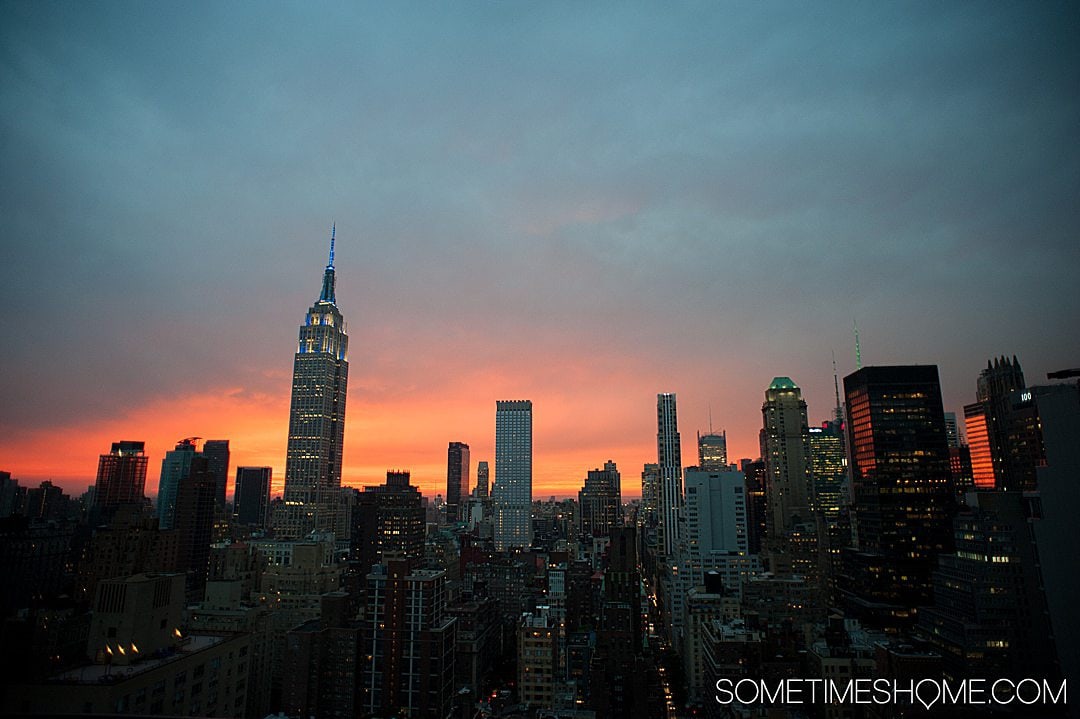
Post Contents
Metro-North is Part of the MTA
Don’t be confused if you see “MTA” on the trains. Metro-North Railroad (sometimes abbreviated “MNR”) is part of the Metropolitan Transit Authority , just like Long Island Railroad (LIRR) is.
Things to Know about MTA Metro-North Railroad in NYC
Where to board metro-north train within nyc: grand central or harlem, grand central terminal (or grand central station as some people call it).
The easiest place to catch Metro-North from a lot of areas in NYC (Manhattan included) is Grand Central Terminal , located on 42nd St. and Park Ave. (It’s abbreviated “GCT” on the Metro-North website.)
Generally speaking, Grand Central Terminal is convenient for many NYC residents and visitors, including if you’re coming from Brooklyn, Queens, or Staten Island. Especially if you’re staying within 10 to 15 blocks north or south in midtown-east, like at this Parisian-inspired hotel .
Simply take the subway to Grand Central and voila: hop on board Metro-North to continue on one of Metro-North’s three lines: Harlem, Hudson or New Haven.
Harlem/125th Street Station
This isn’t always the case though. For instance, if you’re in Harlem in northern Manhattan, then you have a better option of picking up Metro-North at Harlem/125th Street .
The Harlem Metro-North station is at 125th Street and Park Avenue. Three of the five main lines for MTA Metro-North Railroad pass through here. These lines stop at destinations in New York and Connecticut. They are the Harlem, Hudson, and New Haven lines.
This is great if you want to go from Harlem to the Bronx to visit the NY Botanical Garden, for instance. Or you’re already above midtown Manhattan, around 65th St. or above on the east side, and are continuing north.
It usually doesn’t make sense to go southeast to Grand Central when you can simply hop on a train from further north along the train line in Manhattan. Here are some scenarios in Manhattan where it makes sense for you to board the train at Harlem/125th street station:
- From the upper west side of Manhattan: if you’re already in the 70 street or above, like at 90th street, for example, simply take the red subway line’s 2/3 train northeast to 125th street. Switch to Metro-North there.
- From the upper east side of Manhattan: at 86th street, for instance, take the green subway line 4/5/6 train to 125th street. Then walk a few blocks west to Metro-North at 125th Street and Park Avenue where you’ll pick up the MTA Metro-North Railroad.
You can feel good about using an eco-friendly way of travel when you choose trains. They don’t pollute the air like cars do. And of course, the train is always fun for being fully present with a friend you’re traveling with or getting extra work done.
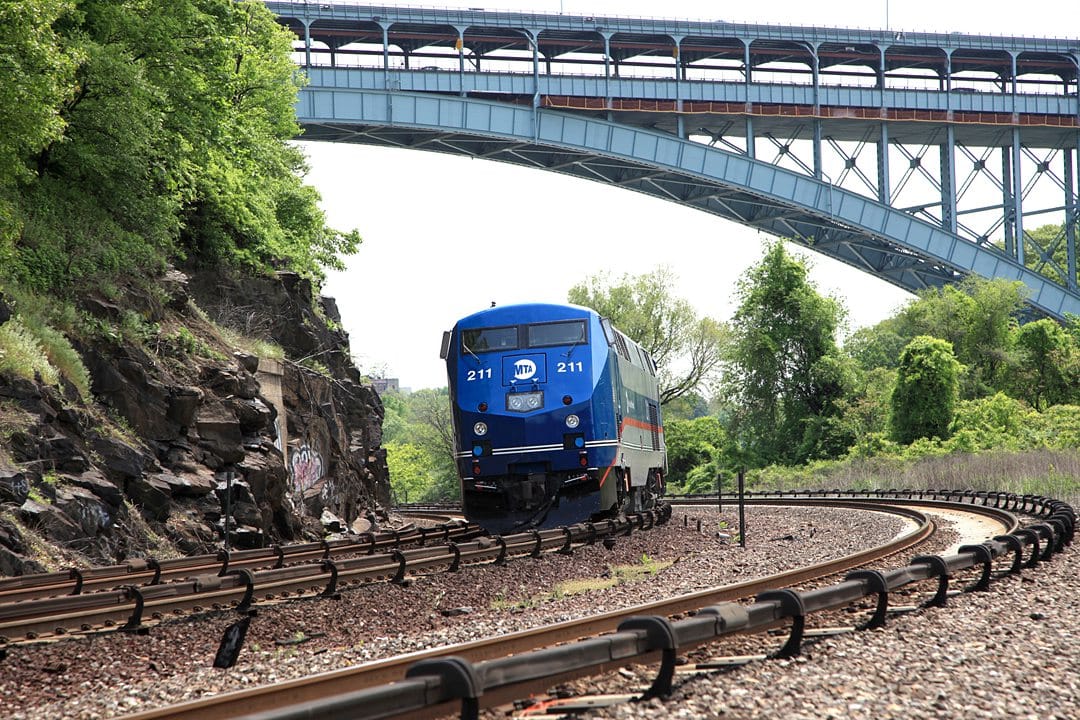
An Important Note on the Size of Grand Central Terminal
Grand Central Terminal (GCT) is LARGE. And it can be confusing if you’ve never been there.
Leave yourself plenty of time to arrive, buy tickets, and potentially wait in line if you need to clarify the tickets you need at a ticket window instead of a machine, discover which platform your train is leaving from, and then time to walk there.
And if you’re touring New York City and you’ve never been to GCT be sure to allot time to see it. Because it’s really impressive and beautiful! It’s one of my favorite places in NYC.
Our suggestion is to book a Secrets of Grand Central Tour for another day or before you head to your destination on Metro-North Railroad. The one-and-a-half-hour tour is very affordable and shares SO MUCH information about GCT, including why it’s a NYC icon and how it was restored years ago. It’s fascinating!
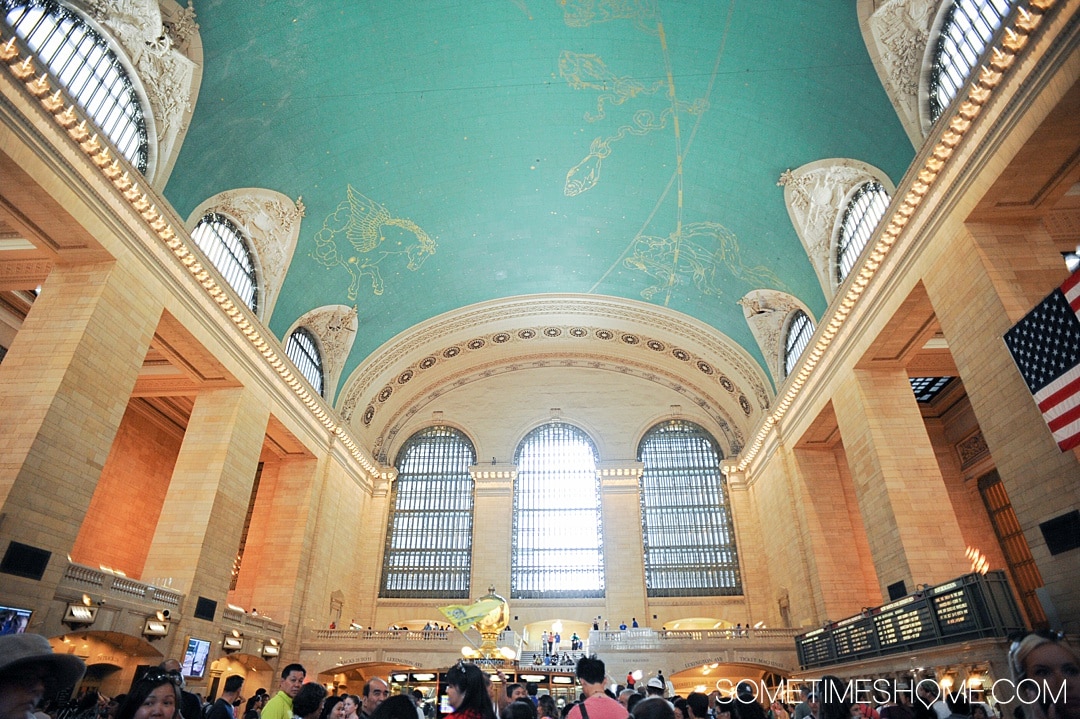
Purchasing Tickets for MTA Metro-North Railroad
Tickets can be purchased onboard, however, there’s an additional fee you’ll pay to do so. We do NOT recommend this.
Instead, download the free MTA eTix app on your smartphone and you can purchase tickets from there.
Purchasing Tickets on the MTA eTix App
There are three things to keep in mind when you do this:
- Create an account to log into the app ahead of time: Don’t wait until the last minute to download the app. You need to create and register an account once you download it and you won’t be able to do that as the train arrives. Leave yourself five to ten minutes to register an account.
- Make sure your phone has plenty of battery: If your phone is about to die you won’t have a way of accessing your ticket to show the train MTA employee. More importantly, you’ll need juice left in your phone to show your return trip ticket hours later. There are a few outlets on the train if you bring along a phone charger, but I wouldn’t rely on it. (The outlets are usually by the seats closest to the train car doors.)
- Activate your ticket on the app before boarding the train: I usually do this as I am literally stepping onboard with the click of a button. (Purchased tickets are in your “Ticket Wallet” on the app.) Don’t do it too far in advance of your train time because it’s only active for a certain amount of time. You cannot deactivate a ticket once it’s activated.
How Long do MTA eTix Stay Active?
The tickets purchased on your app are valid for the same amount of time as paper tickets: 60 days .
However, once you activate a ticket on the app it’s only active for a small amount of time. They don’t reveal exactly how long on their website, but we suspect it’s only for that day or a few hours. (They say it’s active for the “duration of your trip” on their site and the longest ride is only a few hours.)
Reminder: once you activate a ticket you can’t deactivate it.
Purchasing Metro-North Tickets a Ticket Window
Another option is to purchase the tickets in person at a ticket window with a real person or automated ticket machine:
- Ticket window : They’re not open 24/7 but they have pretty good hours. This is a great option if you’re a little confused about what ticket you have to purchase and want to ensure you’re buying the right one. If this is the case, allow extra time at the station. This way you’ll have PLENTY of time to wait in line to purchase the ticket, then get to the train platform, then make the train. There’s very often a wait for ticket windows at Grand Central, especially during peak hours.
- Ticket machine : They’re located all over Grand Central Terminal or near the train station platform at your train stop.
You know the saying “ measure twice, cut once “? Be sure to do that when purchasing your ticket at a machine or online because once it’s yours, it’s yours. They say you can return it within minutes in the app, however, it’s barely worth the extra $10 refund fee if you were only buying a $20 roundtrip ticket, to begin with.
Peak or Off Peak Train Tickets
Be sure you’re purchasing the correct type of ticket for the time you want to travel. Though tickets won’t expire within a day (they’re good for a few weeks) the time you want to travel affects the ticket you need. There’s “Peak” or “Off-Peak”.
The MTA website states the following about peak travel from NYC:
- Peak fares apply to weekday trains that leaves GCT between 6 AM and 9 AM or depart GCT between 4 PM and 8 PM.
The rest of the time is considered Off-Peak. Try to travel during Off-Peak times if you want to save a bit of money on train tickets.
Estimating the cost of your ticket ahead of time is simple. Here’s the easiest way to do it with the Fare Information tool on the MTA site:
- Make sure you have the “ MNR ” tab selected, for Metro-North Railroad .
- Then input the necessary information, including what stations you’re traveling to and from, and what time you want to leave or arrive by.
- When the results come up click on the train you want to select by pressing the right arrow (where we pointed to with a red arrow on the screenshot below).
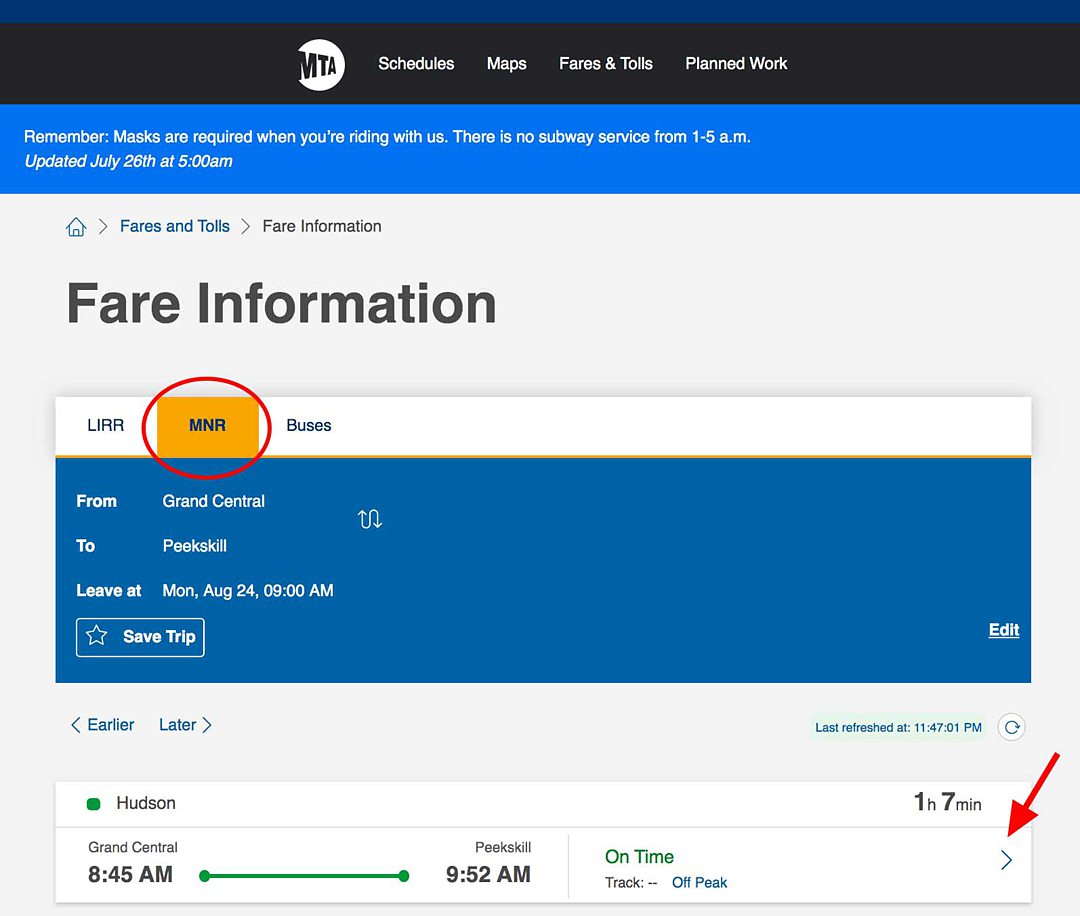
- Then another box pops up indicating the trip information. There’s a tab next to “Trip Information” that says “Fares”. We’ve boxed it in red below. Click that.
- Voila! Your fare options appear. If you’ll be traveling round trip of course you’ll want to locate that price, where we circled below.
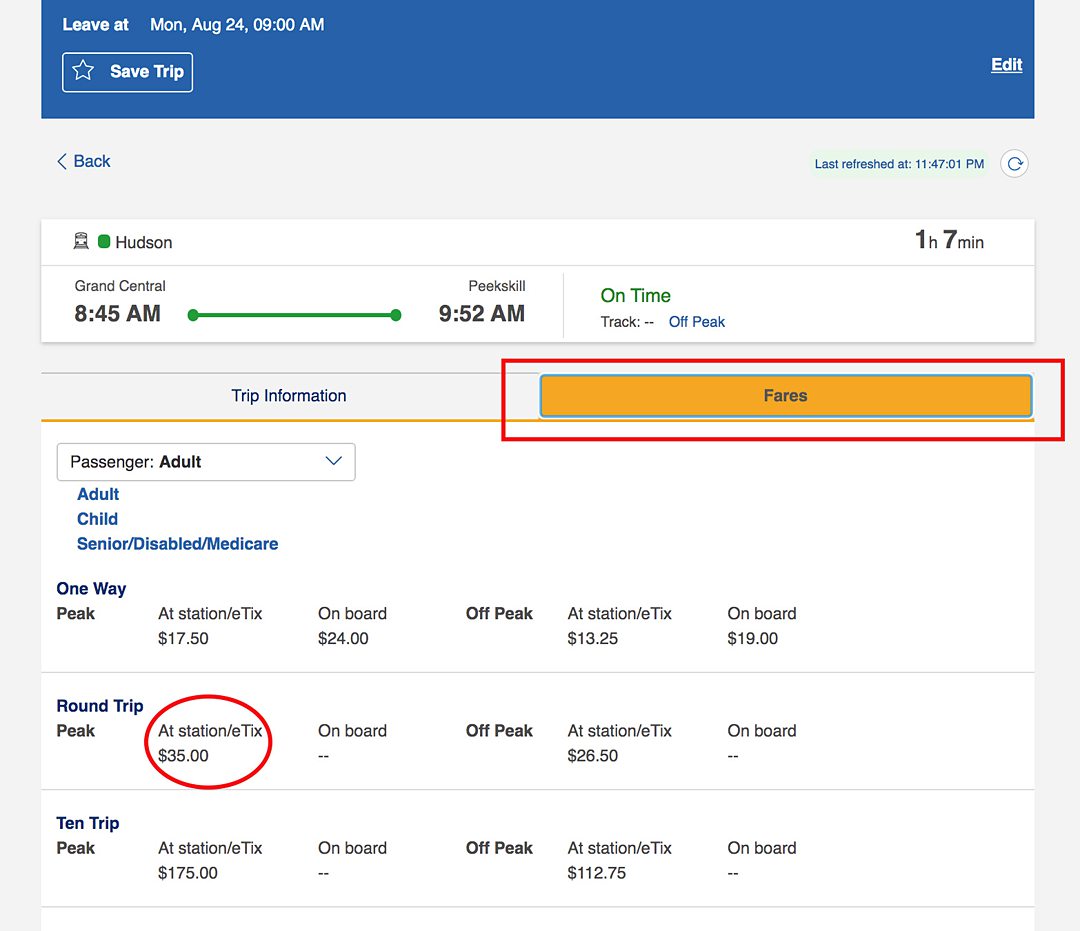

Train Schedules
Train schedules are available on the MTA eTix app or online on the MNR tab. Trains generally run on time but if they’re delayed you’ll be notified on the train platform. You have to plan for it to be on time, though, because the train won’t wait for you. You must be waiting and ready to go!
The exception is at the start or endpoint. So, for example, if you get to Grand Central and your train is leaving from Platform 16 at 10:21am and you arrive at 10:19am it is likely the train is already there with the doors open. You are welcome to board at this point. But it’s only waiting for you because this is the start of the train line.
That’s not the way it works for any stops between the first and last. The doors merely open momentarily for you to board or leave the train. If I had to guess from years of experience with MTA trains, I would say that the Metro-North train doors open for about 30 to 50 seconds on a platform.
If you miss your train, there’s likely another one within the hour. This depends on the popularity of the train line/stops and the time of day. There are fewer scheduled trains during Off-Peak travel times. Peak travel times have more.
Wifi Onboard MTA Metro-North Railroad
Unfortunately, there is no Wi-Fi on board Metro-North trains. We’ve somewhat enjoyed Wifi onboard trains when we travel like when we traveled from Madrid to Zaragoza . But the Wi-Fi’s truthfully never reliable anyway.
There isn’t Wifi on Metro-North trains like there isn’t Wifi on Long Island Railroad.
This is why we recommend a Solis Wi-Fi hotspot if you need to work while you travel. It allows us to rely on the hotspot for a connection, independent of whether we’re on trains or in a car, for instance.
Metro-North Tours and Package Deals
We recently learned that Metro-North partners with many destinations to offer discounted pricing on train tickets and attractions. WOW – our minds were blown! Isn’t that a great partnership? How did I live in NYC for so many years and never know that? Well, as Oprah says, “When you know better, you do better.”
How do you get your hands on any of the packages they offer? Simply purchase one at any station with a full-service ticket vending machine. The only catch is you can’t purchase it at the station where the package is. In other words, you cannot purchase the Dia:Beacon getaway package at the Beacon Station. Yet if you’re at Grand Central Terminal and want to purchase the Dia:Beacon package, you can.
We have our eyes on so many destinations and tours, including a West Point tour, visiting Woodlawn Cemetery and Conservancy, enjoying New York Botanical Garden, seeing Lyndhurst Mansion, and admiring Cold Spring on the Hudson.
Be sure to check the destination you’re traveling to and the Metro-North Getaways website for additional savings. There are a lot of establishments in certain cities, including restaurants and shops, where you’ll get extra savings on purchases simply by showing your train ticket.
Thank you to Metro-North for providing additional images to use for this post.
Visiting new york also check out:.
- Chic Paris Hotel in NYC’s Midtown East Manhattan, Frequented by Stars
- Your Complete Guide to Saugerties, New York
- 10 Free Road Trip Games for Couples (That Families and Kids Can Play Too)
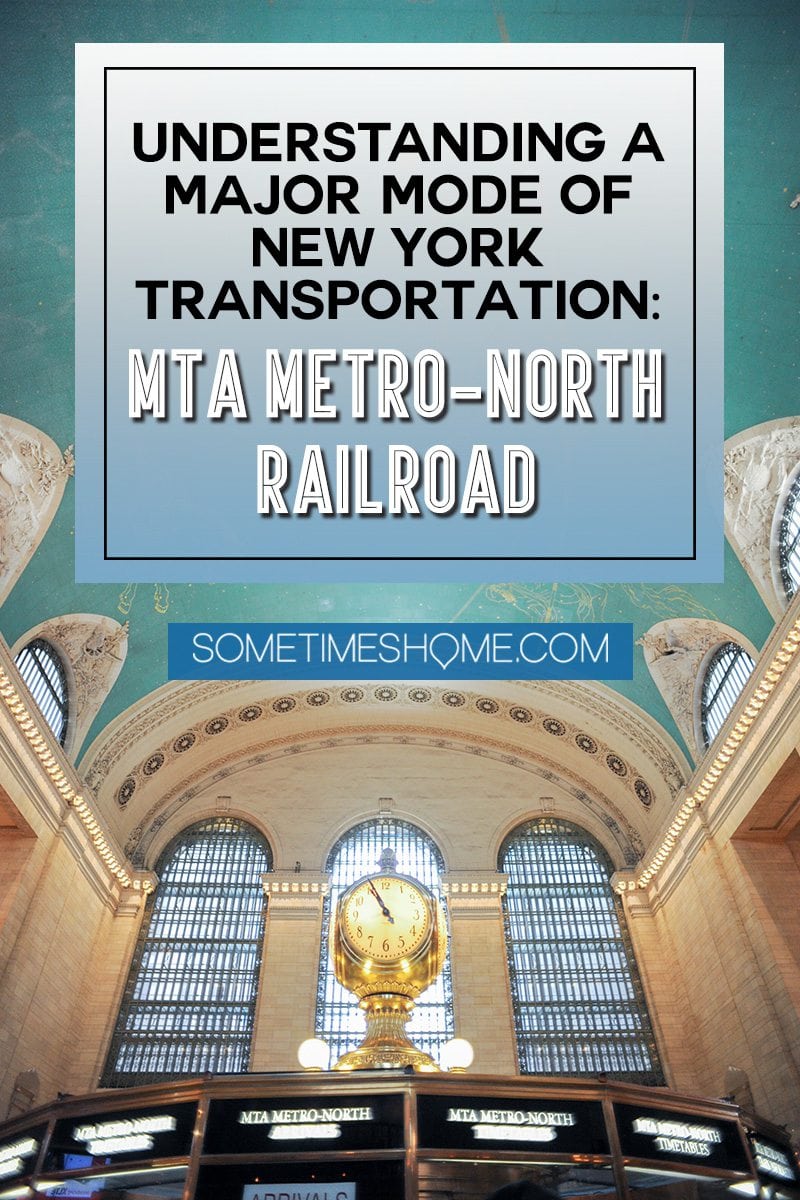
Very informative.. Thank you
Thanks, Hedy! Glad you found the information useful!
Good morning. This is a great article concerning the MTA Metro-North Railroad services and the interesting places to visit. I would like to say that a lot more could be added to the MTA Metro-North Railroad services especially expanding services into Queens and Brooklyn via portions of LIRR Bay Ridge branch along with providing Westside services via Amtrak.
The Secretary of Transportation Pete Buttigieg could aggressively assist in making this possible, with the rebuilding infrastructures plans. MTA’s Metro-North Railroad and Long Island Rail Road services could see great improvements in ridership and along with providing more direct intercity connections. Especially to major airports and hubs.
Thanks again
These are all valid points. We appreciate your readership and thoughts – and definitely encourage you to reach out to your Congressman and Senators, and potentially write (or call) to take action!
Thanks for the helpful information. I just noticed (on the MTA eTix App) that because of COVID, all fares are OFF-PEAK until December 31, 2021!
Great suggestion for buying the ticket on the app. That saves a bunch of time. Another useful app is the Metro-North Train Time app.
We’re so happy to hear that you found the post helpful, Paul. Thanks for the great info about Off-Peak fares on the app. Amazing!
Leave a Reply Cancel reply
Your email address will not be published. Required fields are marked *
- Fares and Tolls
- Access-A-Ride Paratransit
- Accessibility
- About the MTA
- Give feedback
- Sign up for service alerts
- New York City Transit
- Bridges & Tunnels
- Long Island Rail Road
- Metro-North Railroad
- Other agencies and departments
- Planned Service Changes
- Elevator & Escalator Status
- Safety and Security
- Transparency
- Contact the MTA
- Media Relations
- Procurement and solicitations
Need Help Getting on or Off a Metro‑North Train?

July marked the 31st anniversary of the Americans with Disabilities Act! And at the MTA and Metro-North, we take accessibility very seriously.
Metro-North can notify train crews in advance of boarding to provide additional assistance to customers who might need it. If you have advance knowledge of your travel plans and would like to request assistance, here's how you do it:
Call 511 and request help. You can speak with a Customer Service Representative 24/7. (In Connecticut call: 877-690-5114.)
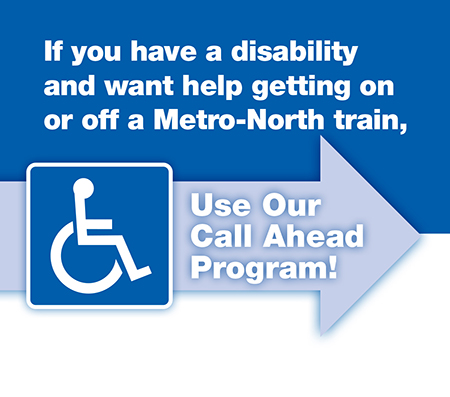
Provide your travel Information. Provide the representative with your departing station, the time you plan to travel, and your destination so they can notify the train crew in advance that you need assistance.
Ask your conductor for assistance. If you are already on a train to Grand Central Terminal, you can ask a conductor for help.
The conductor can call ahead and arrange for an usher to assist you.
Get information

MTA Launches New One Stop Rail App Combining LIRR and Metro-North Trip Planning and Ticket Purchasing
The Metropolitan Transportation Authority (MTA) launched a totally revamped app – named TrainTime – the new one-stop app for commuter rail customers in the region. The app replaces MTA eTix and adds the functionality of previously separate TrainTime apps for Long Island Rail Road and Metro-North Railroad, merging ticket purchasing, trip planning, real-time train location data.
Access your tickets purchased in eTix using your existing account information — or create a new account using your Apple ID, Google account, or a text message.
Making the app easier and more inviting to use, TrainTime users can log in using their Apple ID, Google account, or a text message, and purchase tickets using Apple Pay. These new features complement features that are already popular with MTA app users, including a seat availability tracking and in-app chat with customer service.
Mobile Tickets on TrainTime
TrainTime is the first MTA app where ticket purchasing and trip planning live on the same app. Previously customers would have to use two apps to plan their trip—TrainTime to trip plan, and MTA eTix to purchase tickets.
Now, a customer can search for their train and purchase their ticket in seconds. When looking up their train, a “Buy” ticket button will appear on the screen. From there, a customer can log in using Apple, Google or their phone number and purchase their ticket. Once a ticket is purchased, customers will see the button show “Activate” as their departure time approaches, or “Wallet” if their trip is in the future.
Previous eTix users should use their existing account information to access tickets they have already purchased.
Real-Time Train Movement and Seat Availability Tracking
A core feature of the revamped app is the real-time train tracking map. In preparation for the app’s rollout, GPS sensors were installed on the entire LIRR and Metro-North fleet. When looking up a train a customer can get the exact position of their train in real-time. Once a customer gets on the train, they can continue to track their movement.
The real-time train tracking is complemented by the popular seat availability tracker that the LIRR initially debuted in 2020. A customer can check the exact position of their train while on the train, while also knowing their exact car number and monitor that car’s capacity.
In-App Customer Service
In addition to the many social channels, customers can already go to for assistance, TrainTime meets riders where they are, providing in-app chat with customer service representatives for both railroads for the first time. Users can “Chat with us” on the “Status” tab.
Cross-Rail Trip Planning
The debut of TrainTime allows for a future feature of cross-rail trips when Grand Central Madison opens later this year.
A customer that will travel from Long Island to Metro-North region, and vice versa, will be able to plan their full trip and purchase their ticket without having to use multiple apps.
-via Press Release
Railpace Newsmagazine, ©2020-23 White River Productions. All rights reserved. Railpace Newsmagazine is your one source for the latest news, photos, and features dedicated to railroading in the Northeastern United States and Canada.
- Fares and Tolls
- Access-A-Ride Paratransit
- Accessibility
- About the MTA
- Give feedback
- Sign up for service alerts
- New York City Transit
- Bridges & Tunnels
- Long Island Rail Road
- Metro-North Railroad
- Other agencies and departments
- Planned Service Changes
- Elevator & Escalator Status
- Safety and Security
- Transparency
- Contact the MTA
- Media Relations
- Procurement and solicitations
New Metro-North schedules in effect Sunday, July 10
Here comes summer — and with it comes new Metro-North schedules on all three east of Hudson branches, starting Sunday, July 10.
On the Hudson Line, two weekday evening local trains have been split into four trains, meaning faster, less crowded trips. While we continue to work on our tracks and infrastructure, some trains have minor schedule changes of up to 5 minutes and weekend Poughkeepsie service is operating hourly.
We’re also adding additional New Haven Line service, including 6 new express trips for New Haven/Bridgeport customers and expanded weekday service on the Waterbury Branch.
Check to see if your trip has changed in the Trip Planner on our homepage or in the TrainTime app.
See details on the new service by line below:
New Haven Line:
- In the evening, the 5:12 p.m. and 6:19 p.m. trains making all local stops from Harrison to Grand Central have been restored to provide additional service options from Westchester County stations to the Bronx and Manhattan.
- The 8:59 a.m. and 9:24 a.m. trans from Stamford that made all local stops to Grand Central will become limited-stop local trains, reducing their trip time by 7-8 minutes. Two local trains are added between Harrison and Grand Central, with a transfer at Harrison between the limited-stop trains and the local trains.
- Additional service between New Haven and Grand Central, and on the Waterbury Branch.
Hudson Line:
Hudson Line customers will see two new peak trains in the evening, designed to fill an existing gap in limited-stop service in the Lower Hudson zone, as well as an additional stop at Yankees-E 153rd St station on a northbound rush-hour train. On weekends, six half-hourly trains between Grand Central and Poughkeepsie are suspended until late September to provide track-access time for crucial infrastructure work in the Bronx between Yankees-E 153rd St and Spuyten Duyvil; Grand Central-Poughkeepsie service will continue to operate hourly all day.
- The 7:28 p.m. and 8:32 p.m. trains from Grand Central that made all local stops to Croton-Harmon will become limited-stop local trains, reducing their trip time by 6-8 minutes. Two local trains are added between Grand Central and Greystone, with a transfer at Yonkers between the local stations and the limited-stop trains.
- The 5:20 p.m. train from Grand Central to Croton-Harmon adds a stop at Yankees-E 153rd St at 5:34 p.m. to provide improved service to riders leaving the borough-government and commercial area near the station.
- Six weekend half-hourly trains between Grand Central and Poughkeepsie are suspended until the end of September to provide track-access time for crucial infrastructure work in the Bronx between Yankees-E 153rd St and Spuyten Duyvil stations. Metro-North continues to provide hourly service all day on weekends between Grand Central and Poughkeepsie.
Harlem Line:
- A new morning reverse-peak express train operates from Grand Central to North White Plains, departing Grand Central at 7:08 a.m., stopping at Harlem/125th Street, White Plains and North White Plains.
VTA First-Time Transit Rider Guide
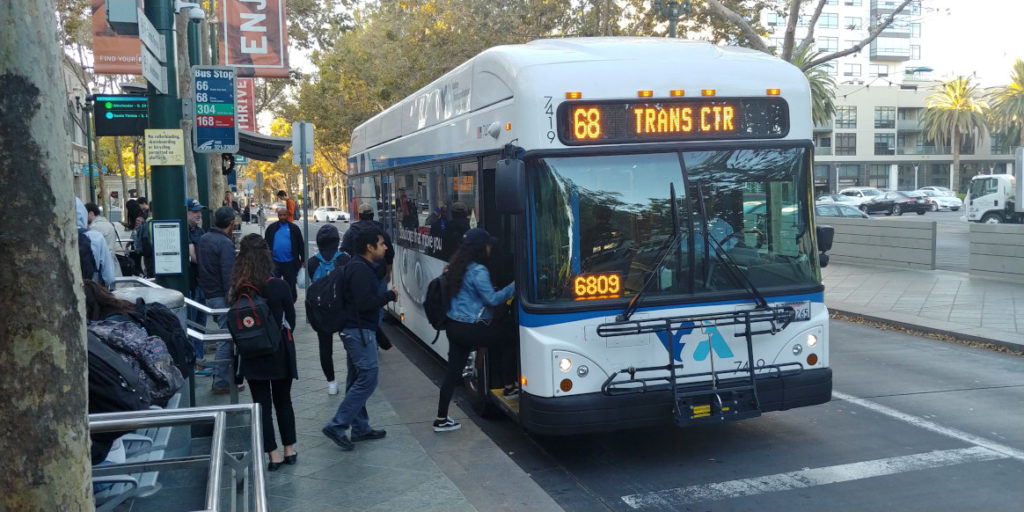
Table of Contents
Mobile phone apps, after vta customer service closes, in person (downtown san jose), how to read a bus schedule, at the bus stop…, how to board a vta bus, boarding a vta bus with your bicycle, how to pay your vta bus fare, basic rules for riding (boarding) any vta bus, how to get off (alighting) from a vta bus, transferring to another bus line, transferring to vta light rail, transferring to commuter or intercity bus or rail services, know before you board, reading the vta light rail schedule, paying vta light rail fare, at the vta light rail station, boarding vta light rail, making room for other people aboard vta light rail, exiting (alighting) vta light rail, transferring to another vta light rail train, commuter rail and intercity rail, commuter bus, inter-county bus, and intercity bus, community buses, connection timing rules between vta and these buses.
Are you visiting, recently moved to or started working in Silicon Valley? New to taking public transportation in the Valley? Taking a Santa Clara Valley Transportation Authority ( VTA ) bus or light rail train can be intimidating for someone riding public transit for the very first time.
This guide will detail the steps you need to make your first trip riding a VTA bus or light rail train as pleasant as possible. It will also detail how to make future trips equally as rewarding and pleasant for yourself – and fellow passengers.
A special “Thank You” must go to San Jose State University’s Transportation Solutions Department for providing all of the basic tips found in this guide.
Note that this guide written independent of VTA. VTA gave us no help whatsoever in the creation of this guide. Please do not contact VTA about particulars in this guide.
Back to Top
Know Before You Go
Not sure which VTA bus or light rail train to take? Not sure when VTA buses or light rail are running and how often? Not sure about how much VTA bus and light rail fares cost? There are several ways you can contact VTA to obtain this information.
By Computer (Online)
VTA has a web site. www.vta.org , available 24 hours/day where you can access public transit information for Santa Clara County.
Also, use VTA’s Online Trip Planner to help plan your bus or light rail trip online. It’s quick and easy. If possible, use the save function or print out the information for your trip reference.
For the entire San Francisco Bay Area, a web site maintained by the Metropolitan Transportation Commission ( MTC) has regional public transit and traffic information. That site, www.511.org , is available 24 hours/day. When visiting the site, click the “Transit” button to obtain public transit information.
Have a smart phone or tablet? Download and install the Transit “app” before you go. The “app” will help you plan your trip, inform you of departure times, and remind you which stop to get off on your bus trip. After downloading the “app” on your smart phone, follow its instructions for its use for the VTA in Santa Clara County.
As of February 2023, VTA has upgraded Transit app users to the Transit Royale platform. Here’s more information from VTA on what Transit Royale does for its users.
Also, you are strongly encouraged to use the Clipper Card app to help pay your bus and/or light rail fare. It will help ease paying transit fares, and speed your trip.
Both the “Transit” app and Clipper Card app are available at the Apple Store or Google Play . Download them and install them on your smart phone (or tablet) today, to help you ride and pay fare on VTA.
By Telephone
Don’t have access to a computer or smartphone? Another way to contact VTA for information is by telephone at (408)321-2300. As of October 2018, VTA’s Customer Service call center hours are
- Monday-Friday from 6am-7pm
- Saturdays from 7:30am-4pm
- Closed Sundays and major holidays
Information is available in English, Spanish, and several other languages. When calling, listen to the voice prompt and dial the number for which language you want the information in.
Have a pencil (or pen) and paper ready to write down the information for your trip. Make sure to note as much information as you can, to make your bus trip easier.
When calling, tell the Customer Service operator:
- Where you are coming from (your exact address, landmark, shopping mall, school, etc.) to start your trip
- Where you are going (exact address, major intersection, landmark, shopping mall, school, etc.)
- What time and date you want to go (be as exact as possible)
The VTA Customer Service operator will tell you:
- the closest bus or light rail stop (typically near the corner of an intersection, or a transit center)
- bus and/or light rail route(s) and destination(s)
- where to get off the bus or light rail train
- How much the transit ride will cost, one-way and round trip.
If the operator does not provide this information for you up front, ask for this information during the call.
Need public transit information when VTA Customer Service is closed for the day? Below are two ways to obtain transit information.
Got a computer or smart phone? Visit VTA’s web site for public transit information. Alternately, use VTA’s online trip planner to help you plan your trip.
Can’t access a computer or smart phone? From any telephone in the San Francisco Bay Area, dial 511 – the San Francisco Bay Area’s public transit and traffic information number. When prompted, say “Departure Times” then follow the voice prompts afterward to obtain the public transit information you need.
VTA has a Customer Service Center at 55-A West Santa Clara Street (east of North 1st Street) in downtown San Jose. They are open from 9am-6pm on weekdays only. The In-Person Center is closed on weekends and major holidays.
How To Ride VTA Buses
VTA operates several types of bus services throughout Santa Clara County. Unless otherwise noted, standard fare for non-Express VTA bus lines applies.
Newer VTA buses and the Winchester (Campbell), Alum Rock (East San Jose), and Ohlone-Chynoweth (South San Jose) transit centers have wireless internet access available. Here’s how to use VTA’s public Wi-Fi network, where available . (Information is as of November 2021)
“Local” VTA bus service ( bus route numbers 1-99 )
- has bus stops closely spaced together
- typically serve a small area, connecting transit centers and rail stations to the surrounding community, a downtown area, or major destinations
- use 35-foot or 40-foot (standard) size buses depending on time of day and ridership patterns.
- historically high-ridership bus lines like the 22 along El Camino Real use 60-foot “articulated” buses.
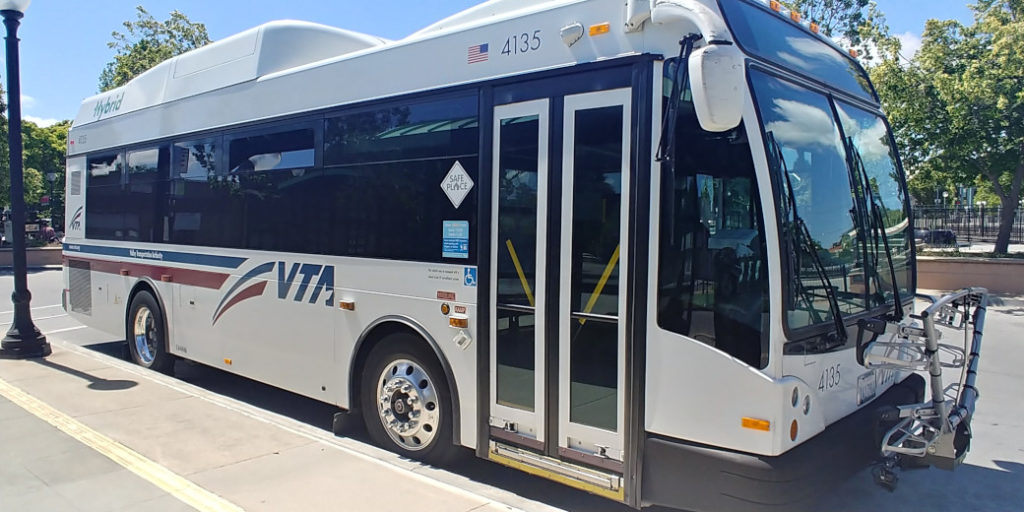
“Frequent” VTA bus service ( bus route numbers 1-99; also applies to “Rapid” buses )
- share many of the same attributes as “Local” bus service
- run every 15 minutes or sooner on Mondays-Fridays from 6:30am-6:30pm
- run every 15-30 minutes on Saturdays, Sundays, and major holidays+
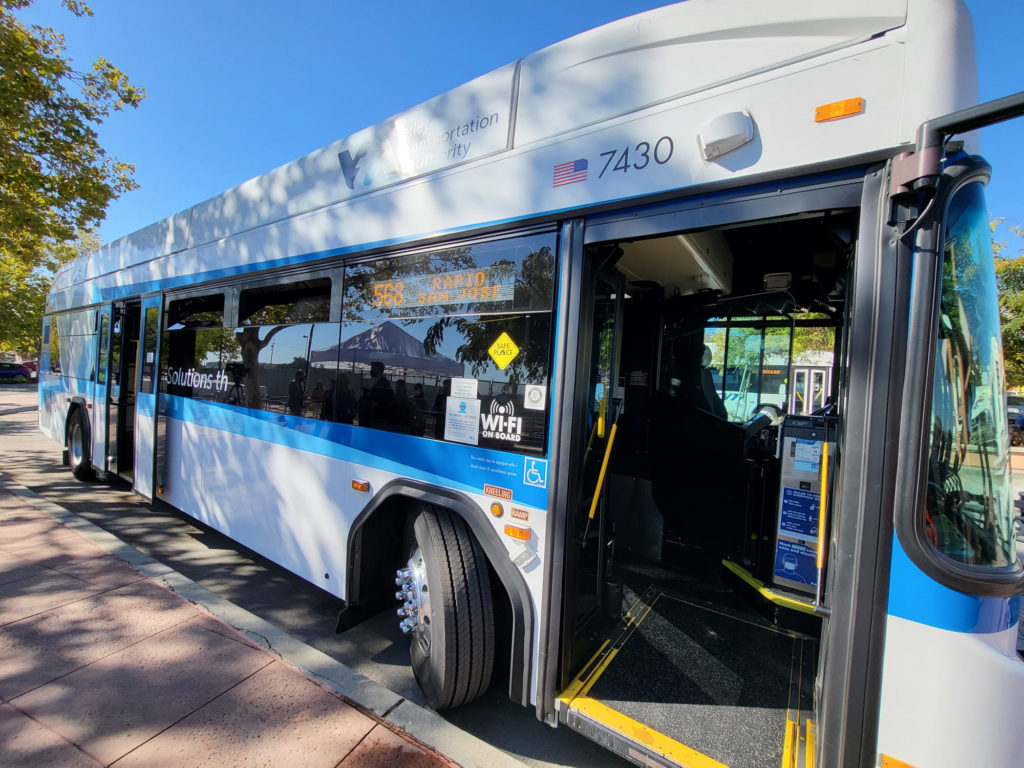
“Rapid” VTA bus service ( bus route numbers 500-599 – often formerly known as “Limited Stop” bus service )
- has the same frequency as “frequent” VTA bus lines
- can leave bus stops up to 5 minutes earlier than scheduled time, as traffic allows
- make only a fraction of bus stops than local bus lines they run alongside (Example: 68 between SJ-Gilroy makes 95 stops, while the 568 Rapid bus between the same cities makes only 19 stops.)
- provide more timed & extensive connections at transit centers
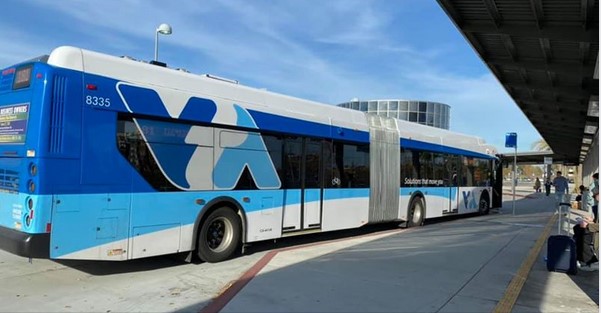
“Express” VTA bus service (bus route numbers 100-199)
- adult fares are double that of standard VTA fares; Youth and Senior/Disabled passengers pay their standard fares
- run only on weekday peak periods. They do not run on weekends nor holidays.
- stop only at transit centers, industrial parks, park-and-ride lots, and major intersections
- operate to industrial parks in the morning only
- operate from industrial parks in the evening only
- operate mainly on freeways (state, Interstate, and U.S.) within Santa Clara County
- typically use “ suburban style ” buses that also have individual reading lights and Wi-Fi capability on-board
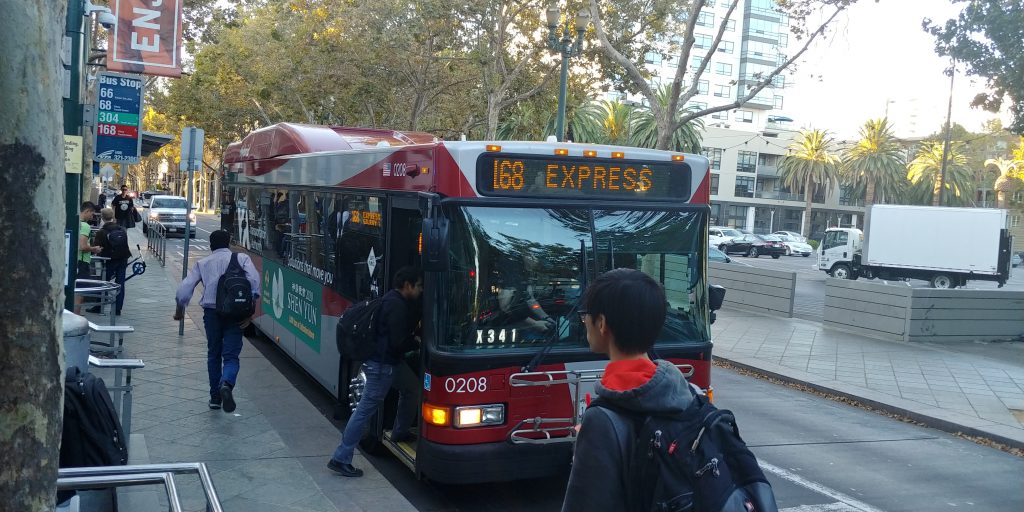
On school days, VTA “ school trippers ” are special services that typically operate to and from public elementary or high schools throughout Santa Clara County. Route numbers for school trippers are in the 200-299 range. School tripper service operates:
- to school in the morning
- from school in the afternoon after school dismisses for the day
- same service philosophy as “Local” bus service
Here is a list of all current VTA bus and light rail lines, and their operating schedules .
All bus schedules are read from left to right. Most routes go in two directions (north/south or east/west). The origin and the destination are indicated in the timetables. Not all bus stops are listed on the schedule. The bus stops listed are called timepoints . The timepoints are also identified in the route maps.
A photo showing an example bus schedule is below.
- Find the time point (column) for your starting point or closest to and before your starting point. For instance, you live one block from Main and Hale, so you would use the Main and Hale time point.
- Go down the column underneath the time point to find the time closest to when you want to catch the bus. Using the example bus schedule, you want to leave Main and Hale by bus at 2pm. However, the next bus is schedule to leave at 2:08pm.
- If you need to be somewhere by a certain time, find the time point closest to where you are going and what time the bus will arrive there. Work your way back to where you will begin your trip to find out what time you will need to get on the bus. For instance, you want to be at Burnett Avenue by 8:30am for an appointment. The closest time for bus arrival at Burnett Avenue is 7:53am. If you are taking the bus from Main and Hale, you would need to catch the bus due to depart Main and Hale at 7:28am.
We recommend arriving at a bus stop at least five minutes before the time shown on the timetable. This allows time to gather the exact fare or transit pass you will need to pay to board the bus.
VTA bus stops are marked by a blue sign on top of a metal pole. The blue sign will have the bus route number(s), operating frequency, and destination(s) posted on them. They also have VTA’s Customer Service telephone number for any questions you have on this or any other VTA bus or light rail service you wish to use.
Other public transit information, such as arrival times and service updates, is also available by dialing “511” from your mobile telephone. Dial in the five-digit ID number on the bus stop sign for information on arrival times and any delays for the bus you wish to take.
Some VTA bus stops have benches to sit on while you wait. Some VTA bus stops even have shelters to protect you from the elements while you wait.
Some examples of VTA bus stop signs are below.
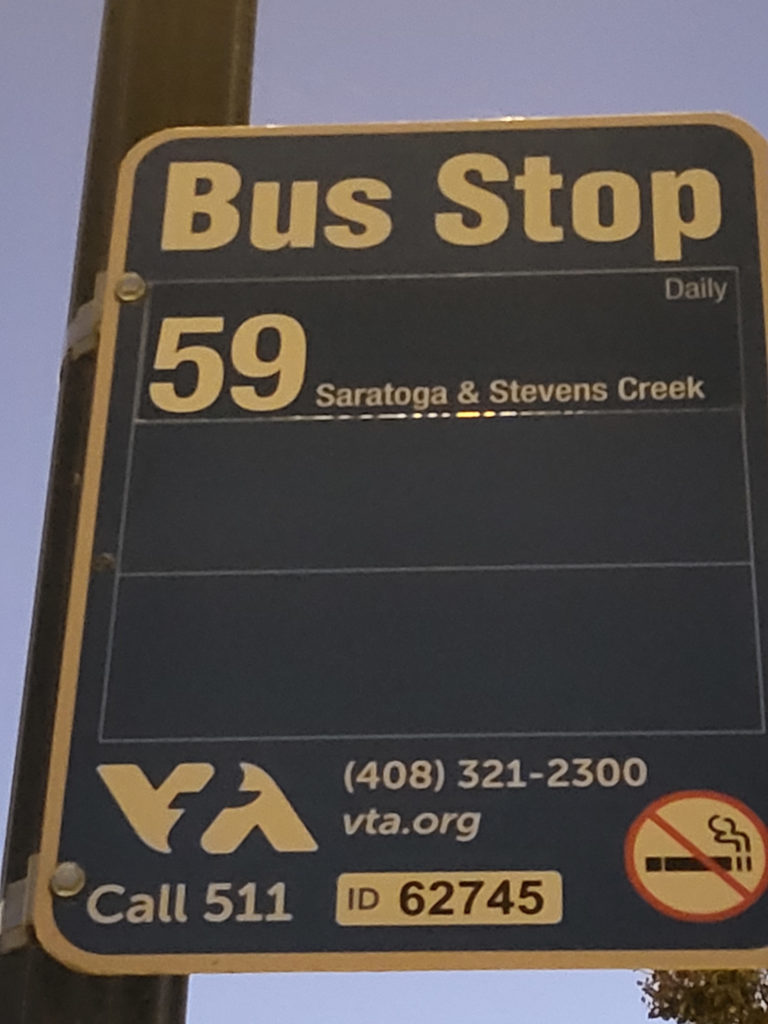
In other words…
- White text on a BLUE background – stop for a “local” bus line
- White text on a RED background – stop for a “frequent” or “rapid” bus line
- White text on a GREEN background – stop for an “express” bus line
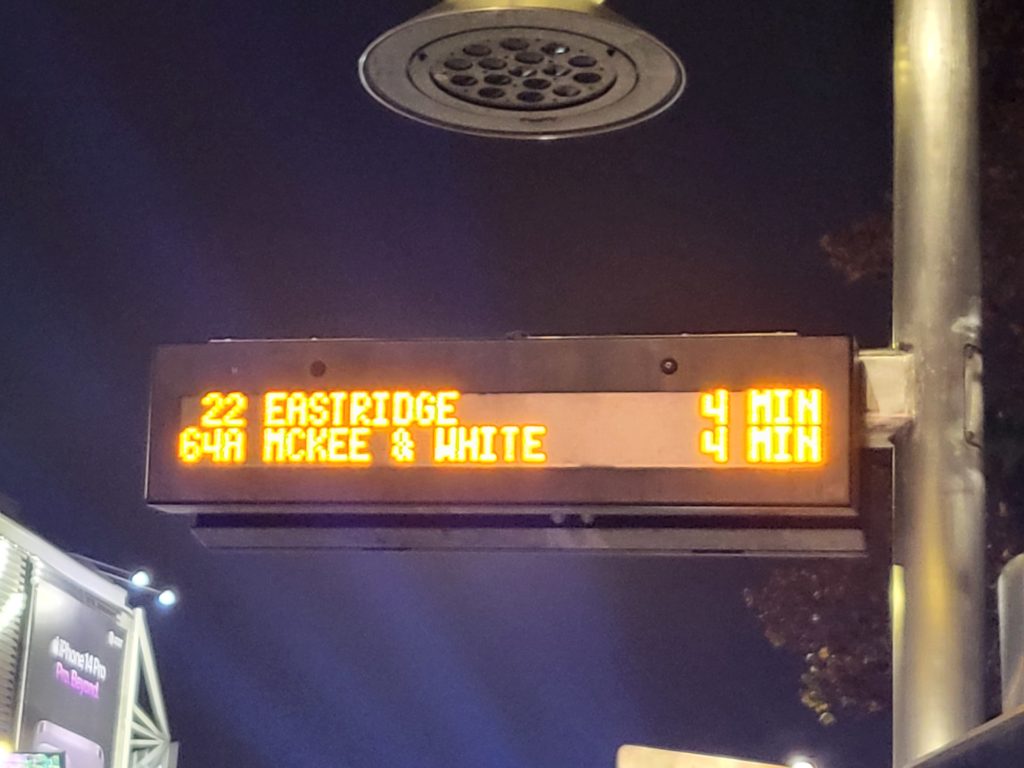
Note that a VTA bus stop may serve more than one bus line. Also note: some VTA bus lines do not stop at all bus stops. It is important that you wait at the correct stop for the correct bus and direction you want to ride. See the above section explaining VTA bus service types , as of November 2021.
Major VTA bus stops and transit centers have electronic real-time boards showing the bus line and estimated time of the next arriving bus. A photo showing what one of these real-time bus arrival displays looks like is below.
The real-time bus arrival signs first show the current time and date. Then, it will scroll to show the bus line, final destination, and estimated time of arrival at the stop, up to one (1) hour later.
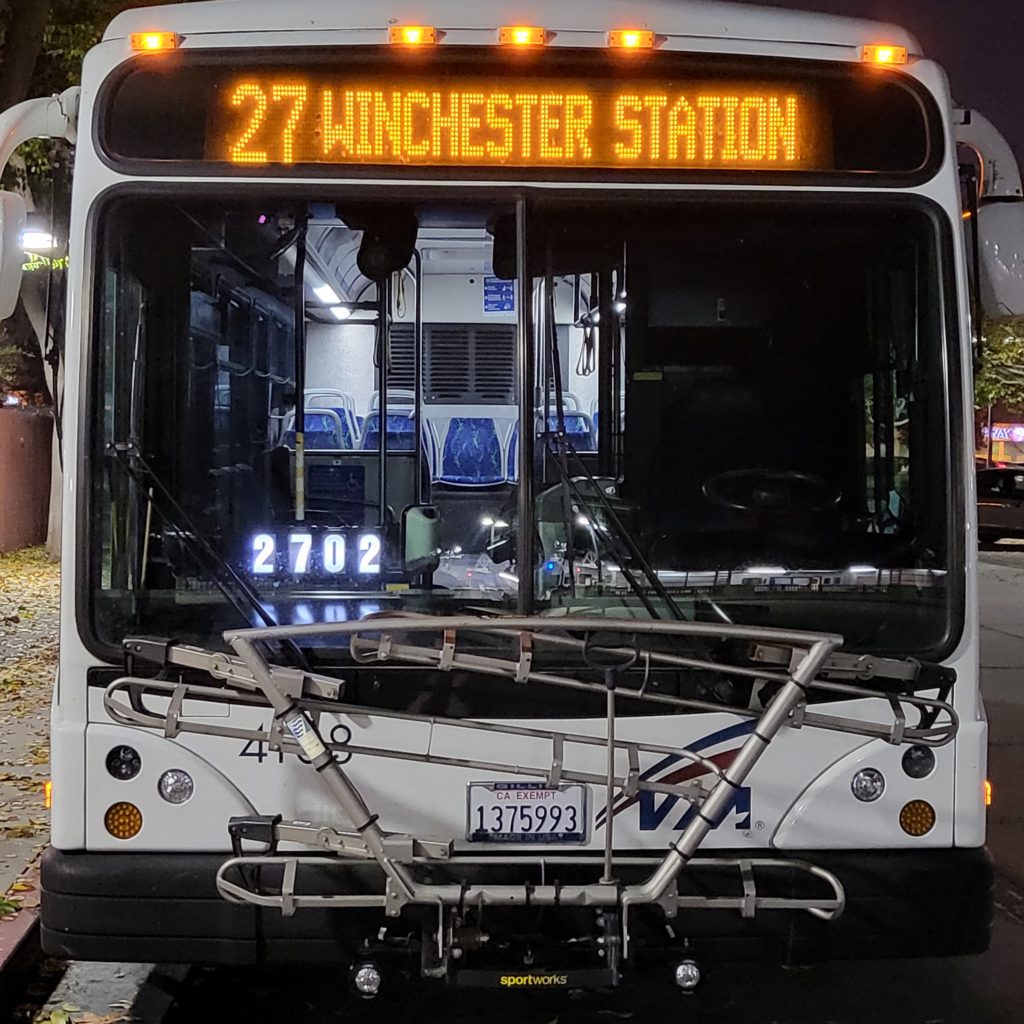
Every VTA bus has its line number and final destination displayed above the windshield, next to the front door, and on the driver’s side of the bus. The bus line number is always displayed at the right rear side of all buses.
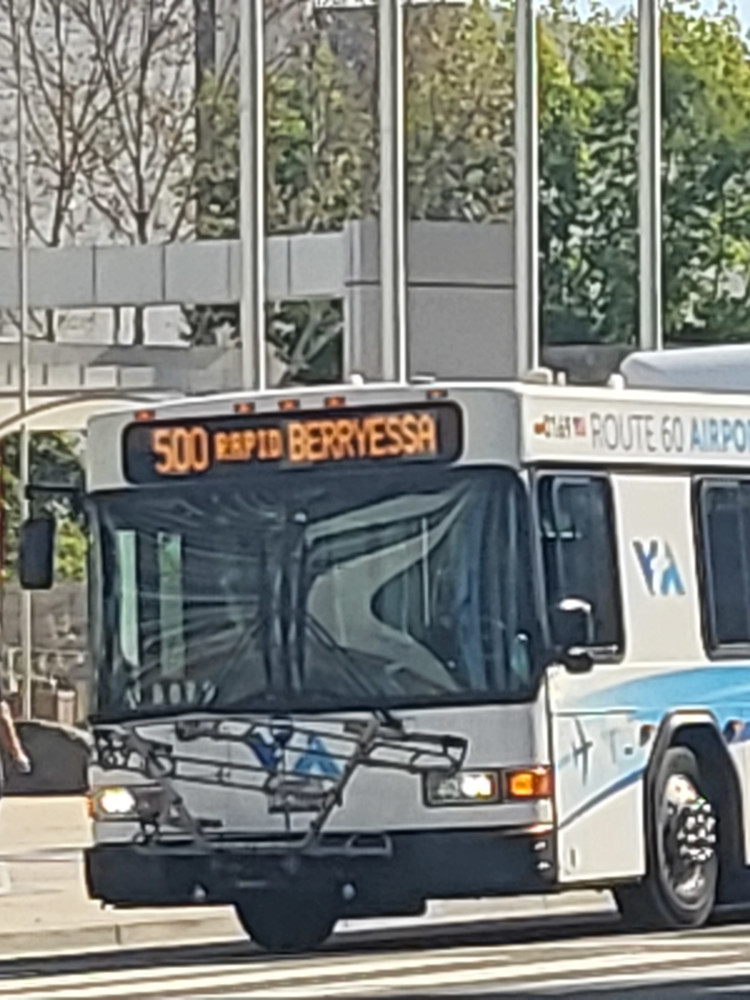
Sometimes, VTA uses buses branded for certain bus routes or services on other routes, due to equipment availability. Make sure to check the front destination sign above the windshield for the correct bus and route. If you are still in doubt, ask the bus driver.
When you see an approaching bus with the correct route and destination, signal the driver by standing near the curb and pointing to the street with either your left arm or right arm. Wait until the bus comes to a complete stop before boarding through the front door.
Riding your bicycle and want to take a VTA bus to where you need to be? This video from VTA’s Bicycle and Pedestrian Advisory Committee from 2009 shows you how to load your bicycle on to the bike rack of any VTA bus.
As a courtesy, allow the elderly, the disabled, or pregnant women to depart the bus from the front door first. If there are any elderly, disabled, or pregnant women boarding the bus afterward, let these people board first.
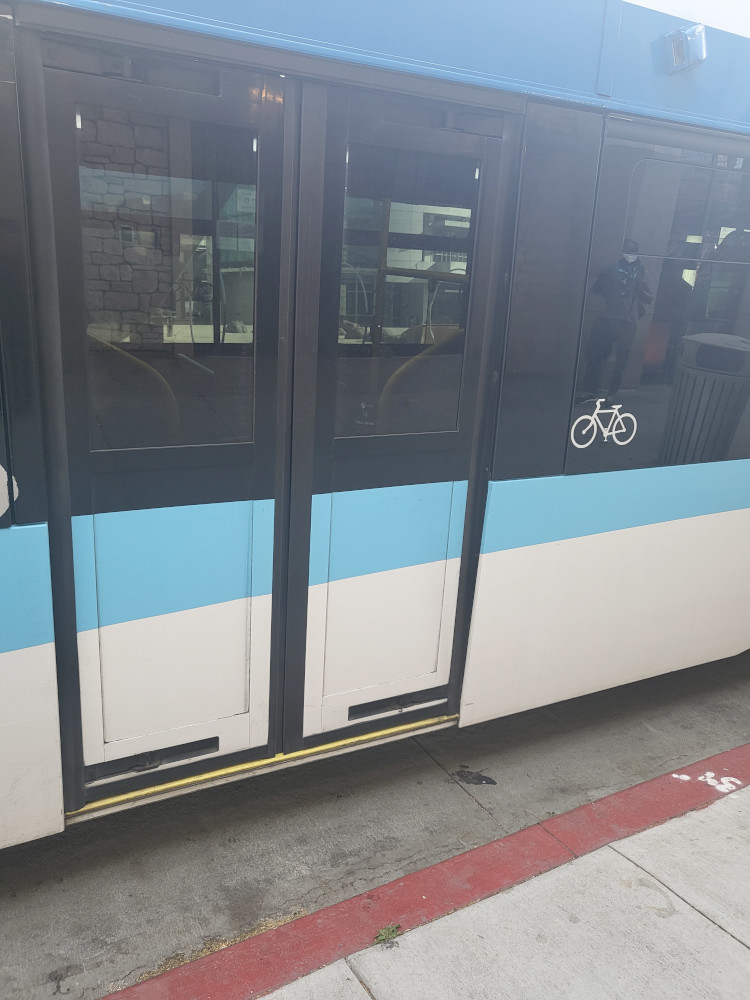
VTA 60-foot articulated buses have a second location to store your bicycle – at the back exit of the bus. To board such a bus, let the bus driver know you are boarding your bicycle at the rear of the bus. If you have cash or a paper pass, make sure to pay your fare at the farebox in front of the driver first. Otherwise, board with your bicycle at the back exit of the bus, tag your Clipper Card at the card reader on the right after you enter, and mount your bicycle on one of the two racks to the right as you enter the bus.
If you have a bicycle on the racks at the front of your VTA bus, let the driver know you have a bicycle in front of the bus, before you exit. This way, the bus driver can safely stop and allow you to remove your bicycle from the rack on the front of the bus.
This chart details VTA bus fares by bus type, and age range. Pay your cash fare inside the fare box at the front of the bus. The photo below shows what a fare box aboard all VTA buses resembles.
VTA has a video detailing how to pay cash fare for the fare boxes aboard its buses.
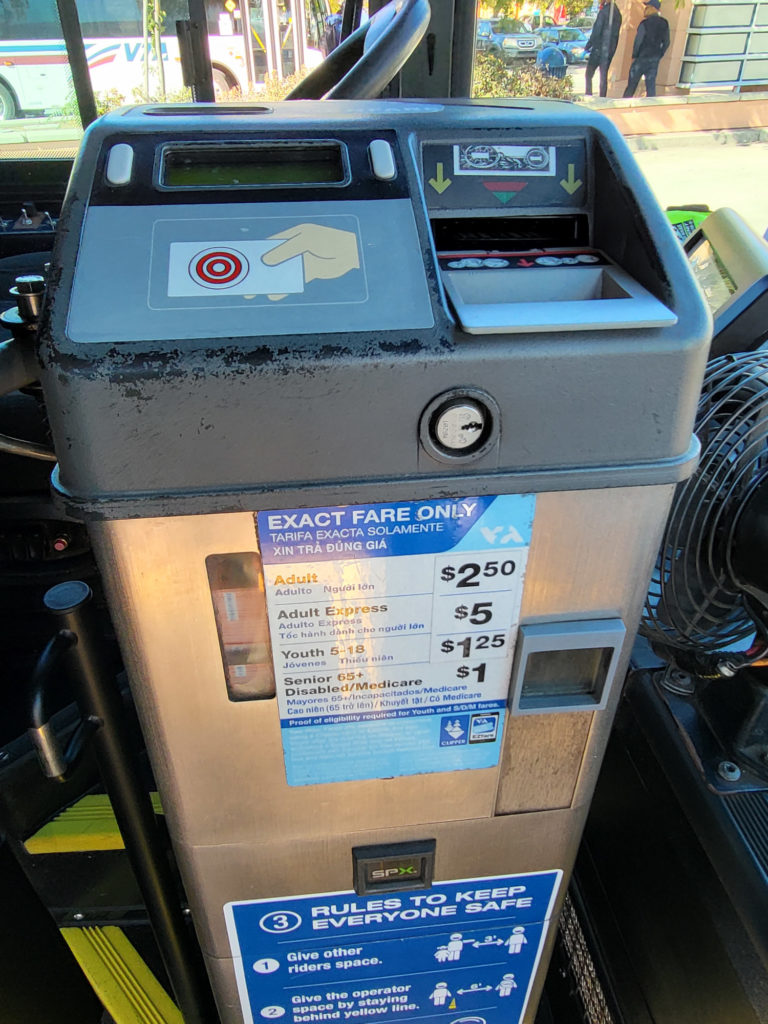
Got a Clipper Card? “Tag” your Clipper Card in the blue area on the white Clipper Card reader aboard any VTA bus. On 35-ft. and 40-ft. buses, the Clipper Card reader is to the right of the fare box. On 60-ft. articulated buses, the Clipper Card reader is to your left, after you enter the bus’s front doors. A Clipper Card reader resembles the photo below.
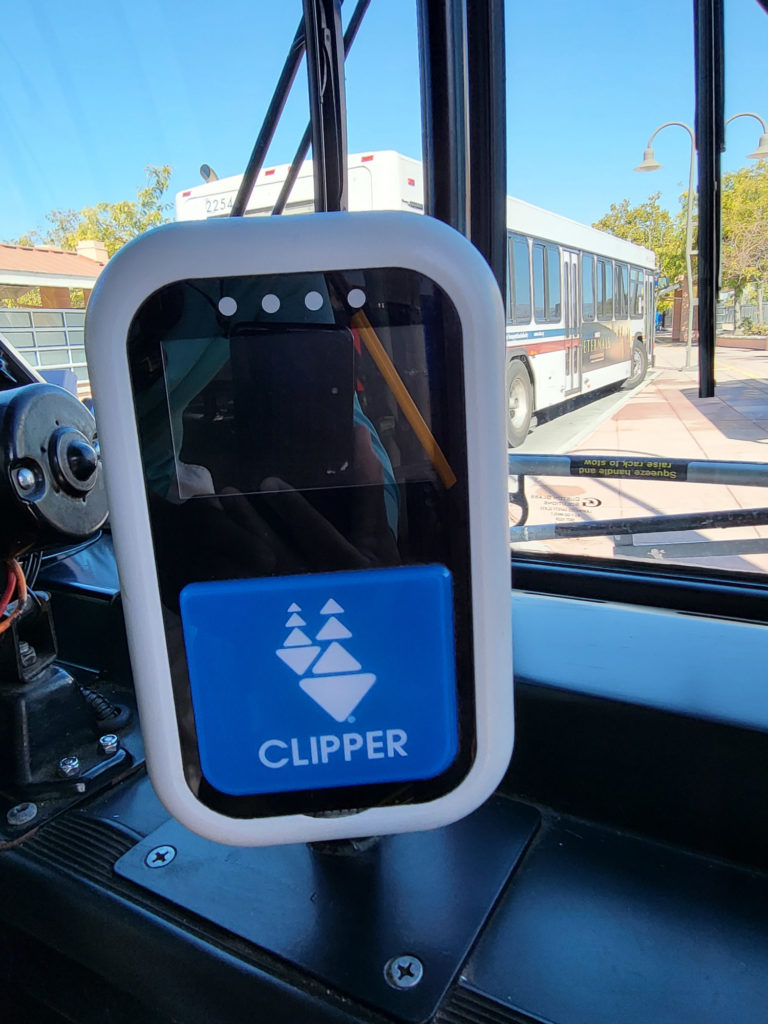
After tagging your card, ensure the Clipper Card reader credits your fare before boarding the bus. This helps speed your bus trip and the trips of those aboard.
Note that there are no more paper day passes available thru the fare boxes as of January 1, 2016. You will need to use your Clipper Card for these passes.
You can acquire a Clipper Card in any of the following ways:
- Ticket Vending Machines (TVMs) at any VTA light rail station
- select Walgreens stores in Santa Clara County
- other retailers in the San Francisco Bay Area
- For your Apple or Android smart phone or tablet, at the Apple Store or Google Play, respectively.
This video from VTA below explains how to purchase a Clipper Card from a VTA light rail ticket vending machine.
After boarding the bus, move to the back of the bus and sit down in any available seat. If required to stand, please remain behind the yellow safety line and hold on to the hand rails provided, above the seats. Try to avoid crowding the front of the bus, especially when standing. This makes it difficult for those sitting to get off the bus at their stops, helping to slow things down.
The front of every VTA bus, behind the driver, has seats facing the aisle. As a courtesy, let seniors, the disabled, and pregnant women sit on those seats. As another courtesy, on crowded buses, offer your seat to a woman (especially a pregnant woman) or a senior. This makes their bus ride – and yours – more pleasant.
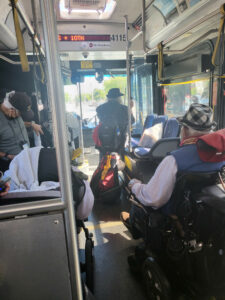
Here are additional rules of etiquette when riding any VTA bus for you to read and learn from. These rules of etiquette, when followed, allow a pleasant transit ride for you and others. Remember: you are riding on PUBLIC transportation.
- VTA buses announce all upcoming bus stops on routes. Make sure to pay attention and listen for the bus stop you want to get off at.
- If you have the Transit “app” on your smart phone, make sure to pay attention to when your bus stop is coming up. Otherwise, If you have no idea on how your destination stop looks like, tell the bus driver where you want to get off.
- Immediately after your bus stop is announced, pull the bell cord or touch the yellow strip on the wall to alert the driver that you’d like to get off at the next bus stop. This will ring a signal chime and light a sign saying “Stop Requested” at the front of the bus. (A smaller “Stop Requested” light will also appear on the bus driver’s dashboard.)
- If able-bodied, leave the bus thru the rear doors. This helps shorten the time the bus is at a stop, ensuring the bus stays on time for other riders. Step as far away from the rear doors, taking all your belongings with you. Never step to the side of a bus’s rear doors – you could slip and fall under the wheels.
VTA Bus Transfers
Some of your trips may require you to take more than one bus line to reach your destination. Sometimes, you may need to transfer on to a light rail or commuter rail system to reach your destination.
If you already have a Clipper Card, here’s how VTA fare is charged between buses or light rail:
Yes. Once you tag on, you'll have 2 hours of free transfers on VTA bus/light rail. If you tag on more than 2 hours later, your Clipper Card will be charged for an additional one-way fare. Multiple one-way fares charged in a single day will cap out at $7.50 (price of a day pass). — VTA (@VTA) December 2, 2021
When planning your trip , give yourself at least five (5) minutes’ lead time, between the time you arrive at the VTA bus connection’s stop, and the time your VTA connecting bus leaves that stop. This will give you time to reach the VTA connecting bus stop(s). Double that time if you are a senior, disabled, or carrying a lot of bags with you.
If you are taking a regional bus service like the Highway 17 Express Bus service , allow at least ten (10) minutes’ lead time to get to its bus stops either in downtown San Jose, or at San Jose Diridon Station .
Plan on riding an intercity service like Greyhound or Megabus ? Allow at least 30 minutes’ lead time between the arriving VTA bus and scheduled departure for your intercity bus. This allows time for you to check yourself and any luggage you carry on to the bus. Help speed your intercity trip by buying your intercity bus ticket in advance.
Make sure to check the bus schedule(s) during your trip planning to allow for the best, fastest travel time between bus lines you will need.
Many VTA bus lines connect with the light rail system throughout Santa Clara County. As with connecting with VTA buses, plan your trip ahead of time, giving yourself at least five (5) minutes between when your bus arrives at the light rail station, and when the light rail train you want departs. Double that time if you are a senior, disabled, or carrying a lot of bags with you.
VTA buses and light rail serve Caltrain stations at Mountain View, San Jose Diridon, and Tamien light rail stations. VTA buses also stop at many stations along the Caltrain corridor in Santa Clara County, from Palo Alto to San Jose to Gilroy.
VTA buses and light rail also serve Capitol Corridor and Altamont Commuter Express stops in Santa Clara and San Jose Diridon. Riding Amtrak anywhere in the United States? VTA buses and light rail serve Amtrak’s only stop in Santa Clara County, at San Jose Diridon Station.
For all rail services except Amtrak, allow at least ten (10) minutes’ lead time between the time your bus arrives, and the time your connecting train departs the station. This will give you time to get to the station platform and buy your train ticket(s) if needed.
When taking Amtrak, allow at least one (1) hour between the time your bus arrives at San Jose Diridon Station, and your Amtrak train’s departure time. This gives you time to check in any baggage you have aboard the train, and to properly “check in” for the departing train as needed.
If you don’t know where your bus is going, ask the bus driver first before boarding. This way, you don’t end up on the wrong bus and stranded.
When riding the bus, if possible, avoid unnecessary conversations with the bus driver. While basic information is to be expected of the bus driver, that bus driver has two primary jobs: keeping the bus and its passengers safe and running the bus on time. In some cases, the bus driver may not be familiar with the area the bus is running through. It’s best to get the information you need for your trip before you depart. Read the previous section above for how to get this information .
How To Ride VTA Light Rail
Below is a map of the VTA Light Rail System, courtesy of VTA.
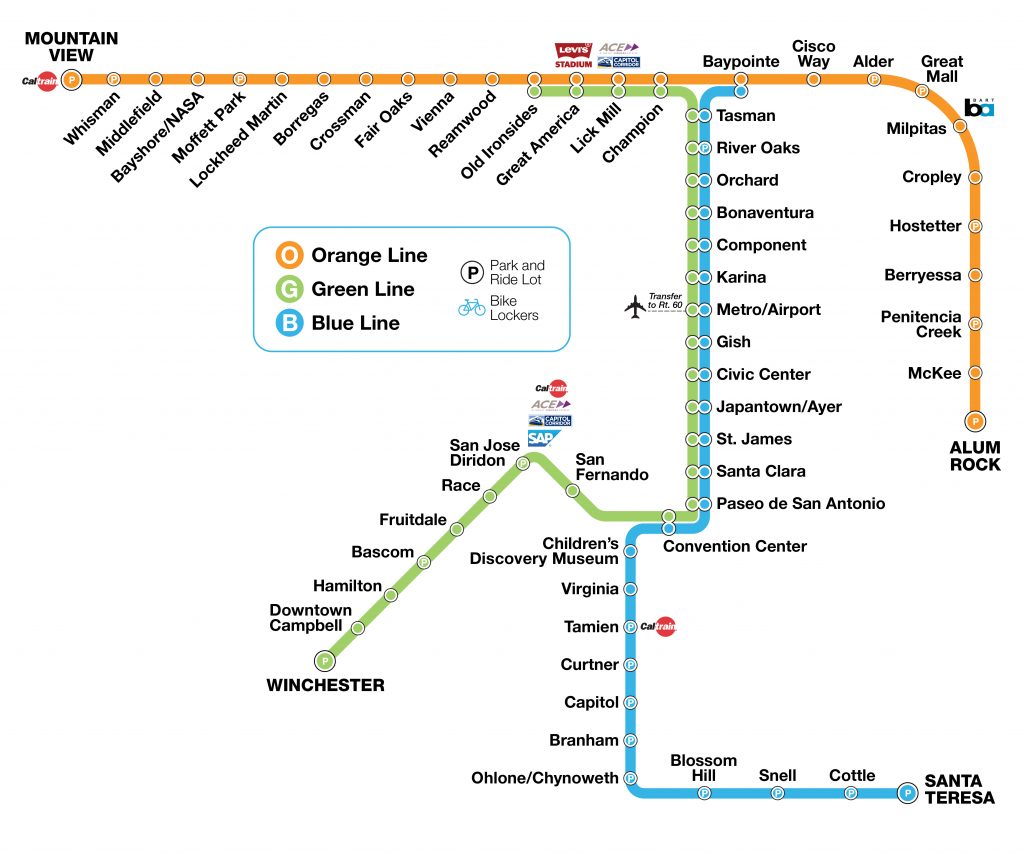
Light Rail stations have level platforms, signs, and shelters. Some stations have a center platform located between the two tracks, side platforms with two tracks in between, or a single platform with only one track. In downtown San Jose, northbound Light Rail trains run on 1st Street while southbound Light Rail trains run on 2nd Street.
FREE wireless internet (“Wi-Fi”) is available on all VTA light rail cars, and at the Winchester, Alum Rock, and Ohlone-Chynoweth light rail stations. Here’s how to use VTA’s public Wi-Fi network .
- Light rail schedules are read from left to right.
- Light rail routes go in two directions (north/south). The origin and the destination are indicated in the timetables.
- Not all stations are listed on the schedule. The stations listed are called timepoints.
- Find the timepoint (column) for your starting point or closest to and before your starting point.
- Go down the column underneath the timepoint to find the time closest to when you want to board the Light Rail.
- If you need to be somewhere by a certain time, find the timepoint closest to where you are going and what time the Light Rail will arrive there. Work your way back to where you will begin your trip to find out what time you will need to get on the Light Rail.
- We recommend arriving at a Light Rail station about five (5) minutes before the time shown on the timetable. If you are a senior or disabled plan on arriving at least ten (10) minutes before the time shown on the timetable.
If you don’t have a valid pass, make sure to purchase your ticket or pass before boarding. Ticket vending machines are available at all stations.
If you have a Clipper Card , make sure to “tag on” with your card at any of the black Clipper Card readers before boarding a VTA light rail train. The below photos show what a Clipper Card fare reader at a VTA light rail station looks like.
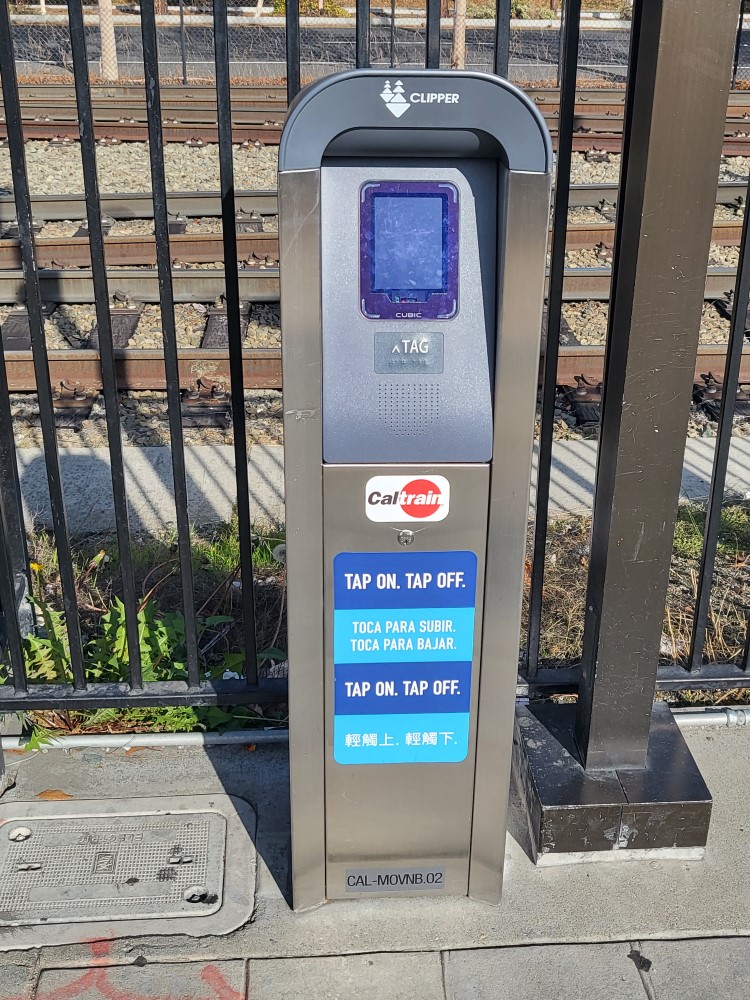
Failure to provide proof of payment to the fare inspector could result in a citation and fine of up to $276 or more.
The video from a light rail rider group below, shows you how to buy an 8-hour excursion pass (good for a round trip ticket) on VTA light rail.
A Clipper Card , when loaded with proper fare, simplifies transfers between light rail, VTA buses, other Bay Area transit agencies, and vice versa. This video from VTA below explains how to purchase a Clipper Card from a VTA light rail ticket vending machine.
Many VTA light rail stations have shelters and benches to protect you from the elements. While waiting for your light rail train, stay behind the yellow line and away from the tracks.
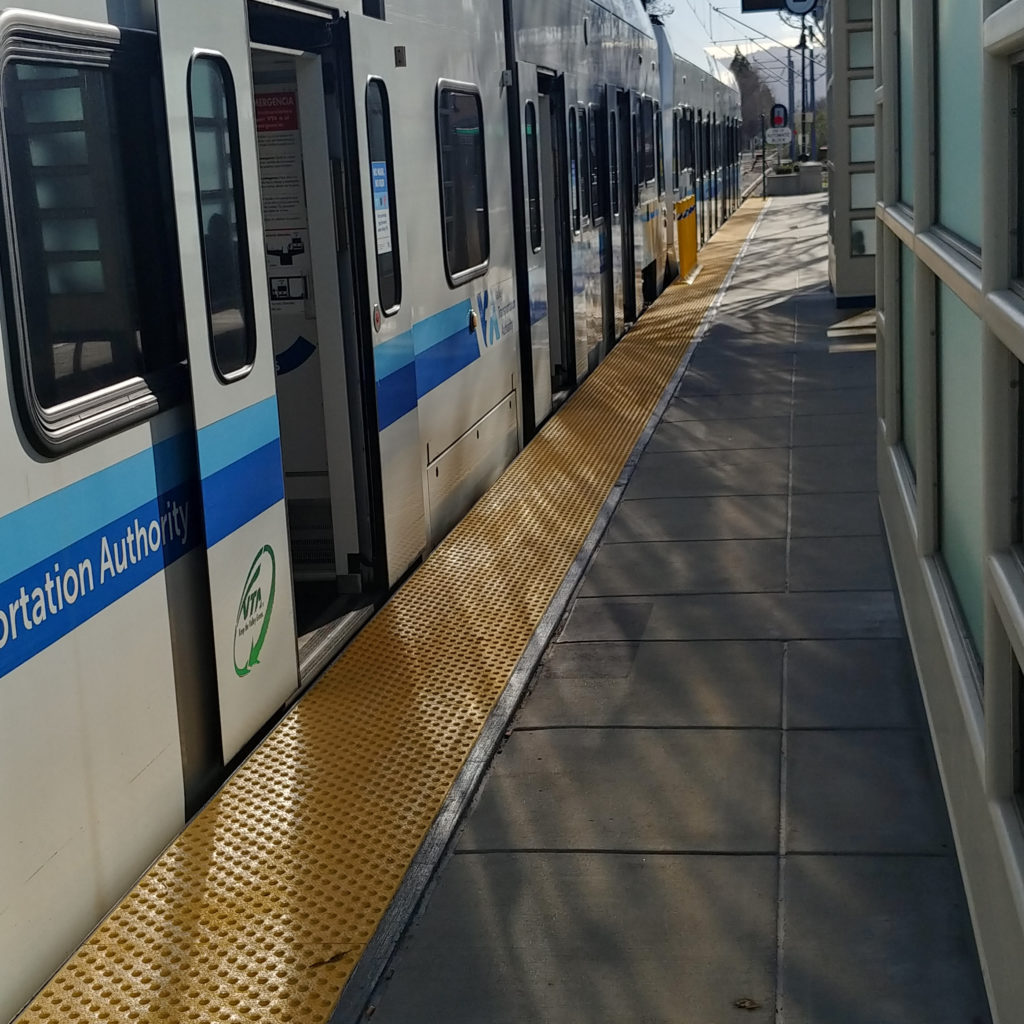
Like any other type of train, light rail trains can run on any track, at any speed, at any time. Light rail trains do not stop instantly; they often require long distances to fully stop.
Here are safety and security tips to help keep you safe at any VTA light rail station.
Every VTA light rail station has a television monitor indicating what line, destination, and when the next train will arrive.
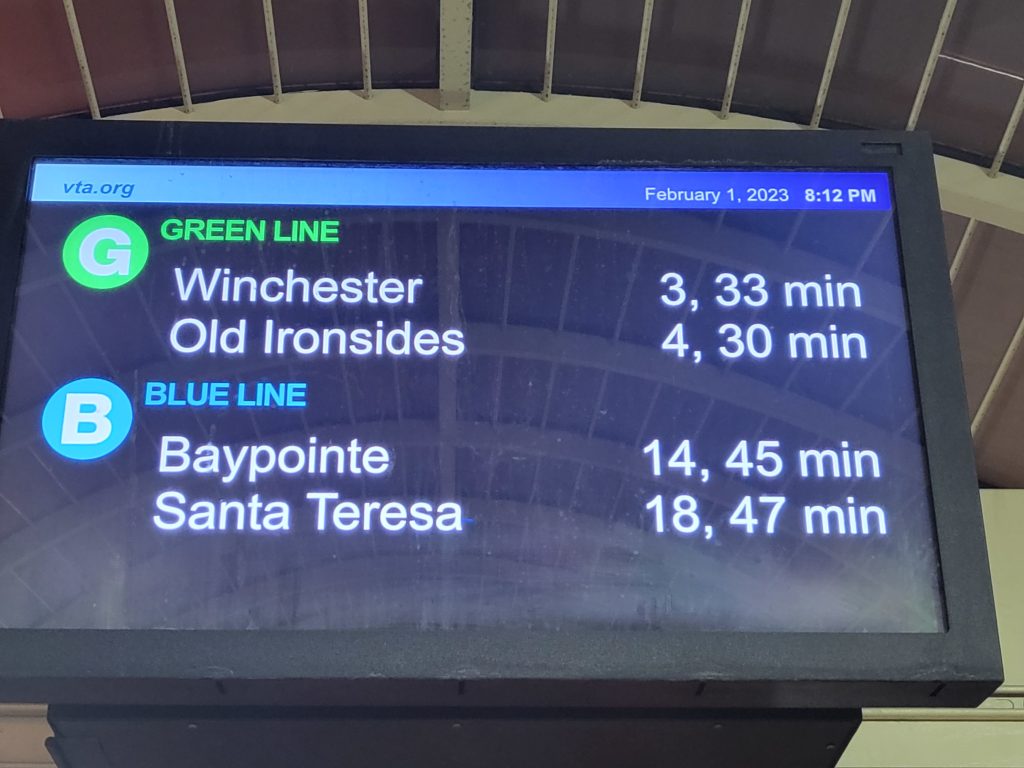
The monitors at each light rail station display the current date and time. They display what lines stop at each station and their estimated arrival time, up to one hour after the current displayed time. Where needed, the monitors also display system status and information on transit alternatives due to maintenance on the system, etc.
As a light rail train approaches the station, make sure to look for the electronic destination signs. The signs and audio announcements will indicate the train’s final destination.
Read the signs on the platforms and by the tracks to make sure that you are waiting for the correct train.
Wait on the platform behind the yellow tactile warning band until the light rail car has come to a complete stop.
The light rail train operator will open doors automatically. Stand clear of the opening doors . After allowing those wishing to leave the train to do so, carefully enter the train. Take a seat or hold the handrails while the train is in motion.
When the four-tone sound plays, it means the doors are closing, and light rail is about to leave. Stand clear of closing VTA light rail doors . Do not block the closing doors of any VTA light rail train – otherwise, you will cause the train and others to be late.
Here are some basic tips on how to make room for other people aboard VTA light rail.
Are you taking a bicycle with you aboard VTA light rail? Make sure to use the vertical bike racks at the center (bending portion) of any VTA light rail car. The photo below shows how to store your bicycle aboard any VTA light rail car.
No room on the bicycle rack(s) for your bicycle? Place your bicycle underneath your seat. Do not place your bicycle (or anything else) in the aisle where it will block other passengers.
Occasionally, a VTA uniformed fare inspector may board the train and ask for a proof-of-payment. When asked, present your pass or ticket to the inspector.
To further help you safely board your bicycle aboard a VTA light rail car, we filmed our own video that shows you how. View that video below.
- Listen to the automated announcement for the name of the next station. If you are about to get off at the next station, press the gray strip (located by the windows) before the train arrives at the station.
- If you have the Transit app on your smart phone, make sure you programmed the phone to tell you where your final destination is, and follow its instructions. Listen to the Transit app for when you need to get off light rail.
- Use caution when exiting Light Rail vehicles. The doors will stay open only a few seconds. As a courtesy, allow seniors, the disabled, or pregnant women to exit light rail first.
- Before exiting light rail, make sure to take any and all of your belongings with you.
VTA Light Rail Transfers
Often, you will need to transfer to a bus or even another type of train to reach your final destination. Below are some tips on how to simply light rail connections to buses and other trains.
As a reminder, here’s how VTA transfers between light rail lines and buses work, particularly if you have a Clipper Card:
When planning your trip , give yourself at least five (5) minutes’ lead time, between the time VTA light rail arrives at your stop, and the time your VTA connecting bus leaves that stop. This will give you time to reach the VTA connecting bus stop. Double that time if you are a senior, disabled, or carrying a lot of bags with you.
Are you taking a regional bus service like the Highway 17 Express Bus service at San Jose Diridon Station? Allow at least ten (10) minutes’ lead time to get to the Highway 17 Express bus stop on the other side of San Jose Diridon Station .
Plan on riding an intercity service like Greyhound or Megabus ? Allow at least 30 minutes’ lead time between the arriving VTA light rail train and scheduled departure for your intercity bus. This allows time for you to check yourself and any luggage you carry on to the bus. Help speed your intercity trip by buying your intercity bus ticket(s) in advance.
Make sure to check the VTA light rail schedule during your trip planning to allow for the best, fastest travel time necessary.
You can connect to another VTA light rail train line at two (2) stations in San Jose:
- Convention Center
Check the VTA Light Rail schedule and allow at least ten (10) minutes for the connecting train. Listen on board the VTA light rail train for stop announcements, to help get you to your final destination.
Transferring to Other Transit Services
Sometimes, your journey may involve taking a local or regional (intercity) bus or train run by another company or agency. This portion of the guide will give you tips on how to handle such a transfer.
VTA buses and light rail serve Caltrain stations in Mountain View, San Jose, Tamien, Morgan Hill, San Martin, and Gilroy.
VTA buses and light rail also serve Capitol Corridor and Altamont Corridor Express (ACE) commuter trains in Santa Clara , and at San Jose Diridon Station .
Riding Amtrak intercity rail anywhere in the United States? VTA light rail serves Amtrak’s only stop in Santa Clara County, at San Jose Diridon Station.
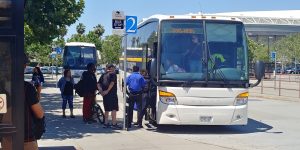
For all rail services except Amtrak, allow at least 15 minutes’ lead time between the time your bus arrives, and the time your connecting train departs the station. This will give you time to get to the station platform and buy your train ticket(s) if needed.
When taking Amtrak, allow at least one (1) hour between the time your VTA bus or light rail arrives at San Jose Diridon Station, and your Amtrak train’s departure time. This gives you time to check in any baggage you have aboard the train, and to properly “check in” for the departing train as needed.
As of July 2019, VTA buses and light rail also connect with following commuter bus and intercity bus services, at San Jose Diridon Station:
- Amtrak Thruway
- Monterey-Salinas Transit ( 55 and 86 bus lines to Monterey, King City, and Paso Robles)
- Santa Cruz Metro ( Highway 17 Express , in cooperation with VTA and Amtrak California)
At the Palo Alto Transit Center , VTA buses also connect with bus services like
- SamTrans (San Mateo County Transit)
- Marguerite shuttle buses to/from Stanford University
- Dumbarton Express bus services to/from the East Bay
At the Gilroy Transit Center, VTA buses connect with bus services like
- International Bus Lines (service throughout California, Tijuana, and Mexicali)
- San Benito County Express (Hollister and San Juan Batista)
In northern Santa Clara County, cities like Palo Alto and Mountain View have their own community shuttles. To supplement corporate employee shuttle buses in that city, Mountain View has an additional shuttle bus service . For those attending or working at Stanford University and related facilities, Marguerite Shuttle buses serves those areas. They typically connect with VTA and Caltrain at the transit centers in Palo Alto and Mountain View, respectively.
Timing rules of thumb to follow when connecting between these services and VTA:
For community bus lines and other bus lines serving local areas: allow at least 10 minutes lead time between arriving and departing connections.
For inter-county bus lines like Santa Cruz Metro, Dumbarton Express, and San Benito County Express: allow at least 15 minutes’ lead time between arriving and departing connections.
For intercity bus lines like Greyhound or Megabus: allow at least 30 minutes’ lead time between arriving and departing connections. This allows allows you time to check your bags in for departure, as needed.
We hope that this guide will give you some basics on how to ride and pay for your VTA bus or light rail trip. This should be especially useful if you are visiting Silicon Valley, or if you have just moved into Silicon Valley from elsewhere.
Please contact us for any questions or corrections to this guide. Your information will help others use public transit in Silicon Valley.
Eugene Bradley Founder, Silicon Valley Transit Users
Michael, Marcia Cohen-Zakai, Monica Mallon, Thomas Mayer, and Judy Purrington contributed to this guide.
3 comments for “ VTA First-Time Transit Rider Guide ”
Super helpful article. Thank you
When going to a SJ Sharks game with a ticket, is it free to ride on light rail ??
DJ: Currently, you still need proper, valid fare to ride light rail – even with a Sharks game ticket. -Eugene
Leave a Reply Cancel reply
Your email address will not be published. Required fields are marked *
Save my name, email, and website in this browser for the next time I comment.
Don't subscribe All new comments Replies to my comments Please notify me of followup comments via e-mail. You can also subscribe without commenting.
This site uses Akismet to reduce spam. Learn how your comment data is processed .
Privacy Overview
Please visit our Light Rail Rehab page for more information on the September 18-22 bus bridge.
Your feedback matters! Take our onboard survey starting September 3 and help shape the future of VTA
Trip Planner
Going to levi's® stadium visit the event information page..
- Route, Direction, Stop
- Street or Stop
All Metrolink lines are operating M-F, and weekend service is available on all lines except Riverside. Plan your trip by selecting an origin and destination station below.
Find a train station
Select a line above.
Select an origin and destination above.
There are no schedules to display
Please select a different origin and destination above to view schedules.
Related Schedules
Subscribe --> HELP First time rider? click here

Select a Station
Locate a station.
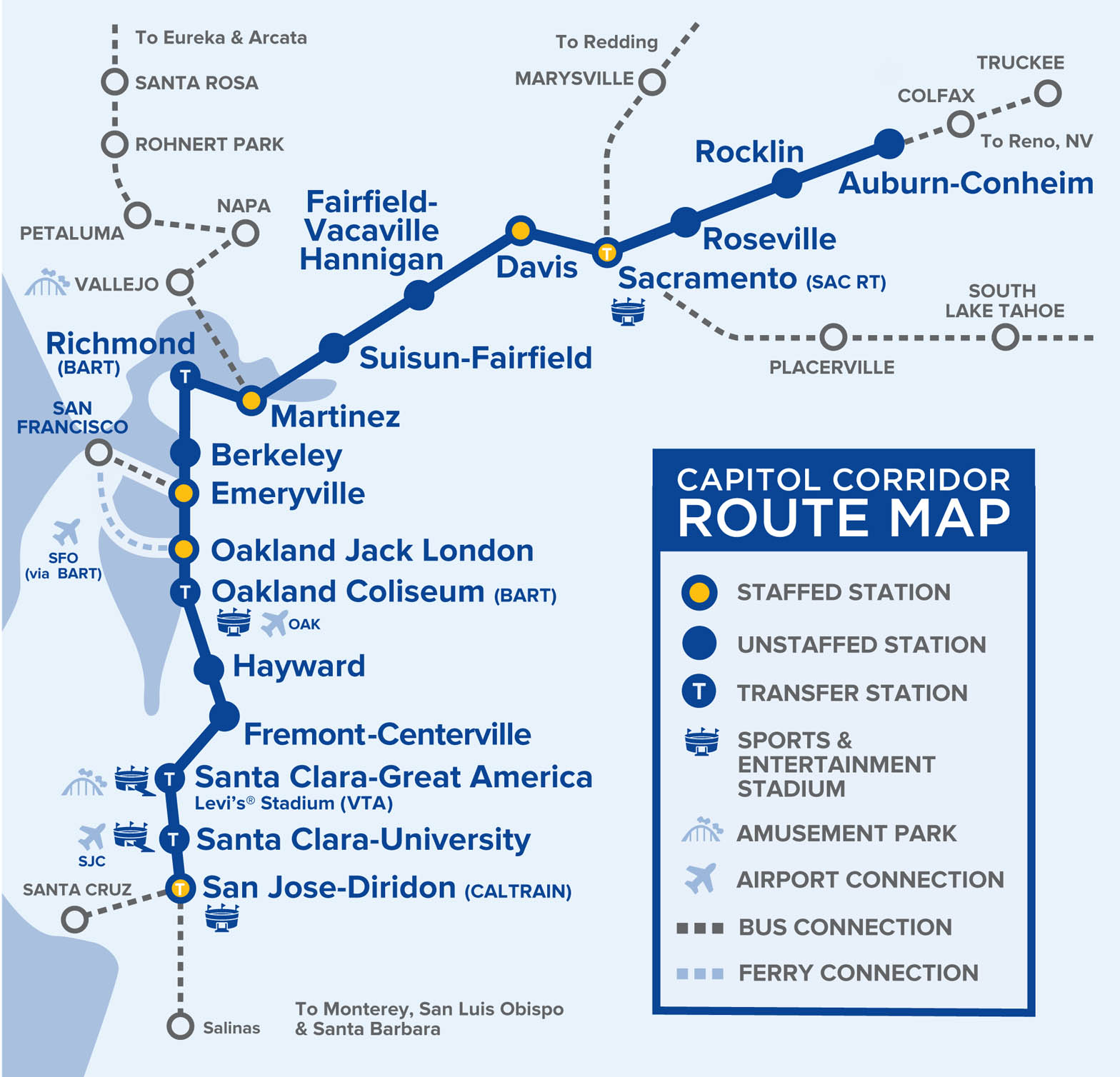
Please complete the form below. Once your request is approved, we will send the appropriate logo file(s) to the email provided.
- Organization
- Purpose for request
- Phone This field is for validation purposes and should be left unchanged.
- Fares and Tolls
- Access-A-Ride Paratransit
- Accessibility
- About the MTA
- Give feedback
- Sign up for service alerts
- New York City Transit
- Bridges & Tunnels
- Long Island Rail Road
- Metro-North Railroad
- Other agencies and departments
- Planned Service Changes
- Elevator & Escalator Status
- Safety and Security
- Transparency
- Contact the MTA
- Media Relations
- Procurement and solicitations
- Agencies and Departments
Metro-North Railroad Schedules
East of hudson: effective april 7-october 5, 2024, east of hudson: effective october 6, 2024, west of hudson: effective may 19, 2024, track work schedules.

IMAGES
VIDEO
COMMENTS
Taking your bike on Metro-North. Explore more with MTA Away New York Botanical Garden. Playland Park. Dia Beacon. See All. Our leadership Catherine Rinaldi. President, MTA Metro-North Railroad. More resources Metro-North Rules and Regulations. Way Ahead - Moving Forward.
We have detected you are using an out-of-date browser. We no longer support this browser, so parts of the site might not work as you expect them to. We recommend updating your browser to the latest version.
View LIRR schedules and Metro-North schedules and fares and download MTA railroad, bus, and subway timetables.
Updated August 17, 2022 12:00 p.m. With our comprehensive TrainTime app, when you ride the Long Island Rail Road or Metro-North Railroad you can: Buy and activate your ticket. Plan trips and see options between up to two origin and two destination stations. View departure times and transfer details for your trip, including for trips using both ...
Trip length: 1 hour, 25 minutes from Grand Central Station on the Hudson Line. On the east side of the Hudson River is the delightful town of Cold Spring. The Metro-North Railroad definitely makes this one of the best day trips from NYC without a car. Cold Spring is the gateway to Hudson Highlands State Park.
In the Tickets tab, enter an origin station on either the LIRR or Metro-North, and a destination station on the other railroad. If Combo Ticket is available for your trip, you will see the option to purchase it. In the Trips tab, plan a trip with an origin station on either the LIRR or Metro-North, and a destination station on the other railroad.
Metro North fares are typically based on distance traveled. The fare structure consists of different zones, with each zone representing a specific geographic area. As you travel farther from New York City, the number of zones increases, resulting in higher fares. To determine the cost of your trip, first identify your starting station and ...
Switch to Metro-North there. From the upper east side of Manhattan: at 86th street, for instance, take the green subway line 4/5/6 train to 125th street. Then walk a few blocks west to Metro-North at 125th Street and Park Avenue where you'll pick up the MTA Metro-North Railroad.
Trip Planning: Trip details including duration, transfer information, fare information, and station stops. Real-Time Train Tracking: Follow your train, in real-time, throughout your trip.
If you have advance knowledge of your travel plans and would like to request assistance, here's how you do it: Call 511 and request help. You can speak with a Customer Service Representative 24/7. (In Connecticut call: 877-690-5114.) We recommend calling one hour prior to your trip. Provide your travel Information.
Cross-Rail Trip Planning. The debut of TrainTime allows for a future feature of cross-rail trips when Grand Central Madison opens later this year. A customer that will travel from Long Island to Metro-North region, and vice versa, will be able to plan their full trip and purchase their ticket without having to use multiple apps.-via Press Release
We recommend updating your browser to the latest version. Home; Agencies and Departments; Metro-North Railroad; Metro-North Railroad Schedules; Metro-North Railroad Schedules Updated Sep 9, 2024. East of Hudson: Effective April 7, 2024 Hudson Line. Harlem Line. New Haven Line.
Updated July 8, 2022 1:41 p.m. Here comes summer — and with it comes new Metro-North schedules on all three east of Hudson branches, starting Sunday, July 10. On the Hudson Line, two weekday evening local trains have been split into four trains, meaning faster, less crowded trips. While we continue to work on our tracks and infrastructure ...
Plan your trip with BART, the convenient and reliable transit system in the Bay Area. Find schedules, fares, maps and more.
VTA 30-foot bus with single door. "Frequent" VTA bus service (bus route numbers 1-99; also applies to "Rapid" buses) share many of the same attributes as "Local" bus service. run every 15 minutes or sooner on Mondays-Fridays from 6:30am-6:30pm. run every 15-30 minutes on Saturdays, Sundays, and major holidays+.
Trip Planner. Body. Going to Levi's® Stadium? Visit the event information page. Real Time; Trip Planner; Schedules; Real Time; Trip Planner; Schedules; ... 2 North Market Street, San Jose, CA 95113 Monday - Friday 9:00 am to 6:00 pm. VTA Headquarters 3331 North First Street, San Jose, CA, 95134
Schedules. All Metrolink lines are operating M-F, and weekend service is available on all lines except Riverside. Plan your trip by selecting an origin and destination station below. View Train Status. Download Full Schedule (PDF) Holiday Schedule. Station To Station Schedules By Train Line. From. Find a train station.
See where Capitol Corridor trains can take you with our route map. See your route, stations, and travel options for trips throughout Northern California.
Thank you for your help . We're planning a trip to New York City, soon, before October 10th. From the hotels rates fluctuations we're we're guessing there's some events happening in the city at the end of September and early October, or maybe it's just that September is a higher priced month.
On Metro-North, peak fares also apply to weekday trains that leaves Grand Central between 6 a.m. and 9 a.m. Off-peak fares are charged all other times on weekdays, all day Saturday and Sunday, and on holidays. Exact fares depend on your trip. The easiest way to see what your trip will cost is by using our schedules or the TrainTime app.
Role in the Region: BART lowers the cost of living in the Bay Area. Track shutdown scheduled for September 21 and 22 in Oakland postponed to October. San Leandro Station: temporary closure of pedestrian entrance starting 9/9. BART launches Transbay Tube Trivia Contest to mark 50 years of service. BART Connects: This rider uses their BART System ...
We recommend updating your browser to the latest version. Home; Agencies and Departments; Metro-North Railroad; Metro-North Railroad Schedules; Metro-North Railroad Schedules Updated Aug 26, 2024. East of Hudson: Effective April 7, 2024 Hudson Line. Harlem Line. New Haven Line.
We have detected you are using an out-of-date browser. We no longer support this browser, so parts of the site might not work as you expect them to.